ARCHIVED - 2009 Reference Case Scenario: Canadian Energy Demand and Supply to 2020 - An Energy Market Assessment
This page has been archived on the Web
Information identified as archived is provided for reference, research or recordkeeping purposes. It is not subject to the Government of Canada Web Standards and has not been altered or updated since it was archived. Please contact us to request a format other than those available.
July 2009

Copyright/Permission to Reproduce
2009 Reference Case Scenario: Canadian Energy Demand and Supply to 2020 - An Energy Market Assessment [ZIP 3208 KB]
(Maintains links between report charts and their associated data, and between appendices and data files.)
2009 Reference Case Scenario: Canadian Energy Demand and Supply to 2020 - An Energy Market Assessment - Appendices [ZIP 2645 KB]
(Maintains links between report charts and their associated data, and between appendices and data files.)
Table of Contents
List of Figures
List of Tables
List of Acronyms and Abbreviations
List of Units
Chapter 2: Energy Context
Oil and Gas Markets - Global and Regional Trends
Government Programs and Policies
Chapter 3: Key Drivers
Energy Prices
Economic Growth
Key Uncertainties to the Outlook
Chapter 4: Energy Demand Outlook
Energy Consumption by Sector
Key Uncertainties to the Outlook
Chapter 5: Crude Oil Supply Outlook
Resources
Crude Oil Supply Outlook
Supply and Demand Balances
Key Uncertainties to the Outlook
Chapter 6: Natural Gas Supply Outlook
Resources
Canadian Natural Gas Production Outlook
Liquefied Natural Gas
Supply and Demand Balance
Key Uncertainties to the Outlook
Chapter 7: Natural Gas Liquids Supply Outlook
NGL Supply and Disposition
Key Uncertainties to the Outlook
Chapter 8: Electricity Supply Outlook
Capacity and Generation
Exports, Imports and Interprovincial Transfers
Key Uncertainties to the Outlook
Chapter 9: Coal Supply Outlook
Key Uncertainties to the Outlook
List of Figures
| ES.1 | Comparison of Historic and Projected Growth Rates - Population, Gross Domestic Product (GDP), End-use Demand |
| 3.1 | West Texas Intermediate Crude Oil Price at Cushing, Oklahoma, Reference Case Scenario and Price Cases |
| 3.2 | Henry Hub Natural Gas Price at Louisiana, Reference Case Scenario and Price Cases |
| 4.1 | Canadian Total Secondary Energy Demand, Reference Case Scenario and Price Cases |
| 4.2 | Comparison of 2009 Reference Case Scenario and 2007 Reference Case End-Use Demand |
| 4.3 | Residential Sector Energy Demand by Fuel, Reference Case Scenario |
| 4.4 | Commercial Sector Energy Demand by Fuel, Reference Case Scenario |
| 4.5 | Industrial Sector Energy Demand by Fuel, Reference Case Scenario |
| 4.6 | Transportation Sector Energy Demand by Mode, Reference Case Scenario |
| 4.7 | Transportation Sector Energy Demand by Fuel, Reference Case Scenario |
| 5.1 | Total Canadian Oil Production, Reference Case Scenario |
| 5.2 | Comparison of 2009 Reference Case Scenario and 2007 Reference Case Crude Oil Supply Outlook |
| 5.3 | Oil Sands Production, Reference Case Scenario |
| 5.4 | Oil Production, Reference Case Scenario and Price Cases |
| 5.5 | Light Crude Oil Balance, Reference Case Scenario |
| 5.6 | Heavy Crude Oil Balance, Reference Case Scenario |
| 6.1 | Projected Natural Gas Wells Drilled, Reference Case Scenario and Price Cases |
| 6.2 | Canadian Natural Gas Production, Reference Case Scenario |
| 6.3 | Comparison of 2009 Reference Case Scenario and 2007 Reference Case Natural Gas Supply Outlook |
| 6.4 | Canadian Natural Gas Production, Reference Case Senario and Price Cases |
| 6.5 | Canadian Net Natural Gas Exports, Reference Case Scenario and Price Cases |
| 7.1 | Ethane Supply and Demand Balance, Reference Case Scenario |
| 8.1 | Canada Electricity Generating Capacity, Reference Case Scenario |
| 8.2 | Generation by Fuel Comparison of 2009 Reference Case Scenario and 2007 Reference Case Scenario |
| 8.3 | Canada Electricity Generation by Fuel, Reference Case Scenario |
| 8.4 | Interprovincial Electricity Transfers and Net Exports, Reference Case Scenario |
| 9.1 | Canadian Coal Production and Disposition, 2005 and 2020, Reference Case Scenario |
List of Tables
| 5.1 | Estimated Initial Capital Expenditure and Threshold Prices for New Oil Sands Projects |
List of Acronyms and Abbreviations
| CBM | Coalbed methane |
| CCS | Carbon capture and storage |
| CNG | Compressed natural gas |
| CO2 | Carbon dioxide |
| EOR | Enhanced Oil Recovery |
| GDP | Gross Domestic Product |
| GHG | Greenhouse gas |
| IEEP | Incremental Ethane Extraction Policy |
| IGCC | Integrated Gasification Combined Cycle |
| LNG | Liquefied Natural Gas |
| NEB | National Energy Board |
| NGLs | Natural Gas Liquids |
| NYMEX | New York Mercantile Exchange |
| OECD | Organisation for Economic Co-operation and Development |
| OPEC | Organization of the Petroleum Exporting Countries |
| U.S. | United States |
| WCSB | Western Canada Sedimentary Basin |
| WTI | West Texas Intermediate |
List of Units
| bbl | barrels |
| b/d | barrels per day |
| Bcf | billion cubic feet |
| Bcf/d | billion cubic feet per day |
| GJ | gigajoule |
| GW | gigawatt |
| GW.h | gigawatt hour |
| m³ | cubic metre |
| m³/d | cubic metres per day |
| Mb/d | thousand barrels per day |
| Mcf | thousand cubic feet |
| MMb/d | million barrels per day |
| MMBtu | million British thermal units |
| Mt | megatonne |
| MW | megawatt |
| PJ | petajoules |
| $ or Cdn$ | Canadian dollars |
| US$ | U.S. dollars |
| Tcf | trillion cubic feet |
| TW.h | terawatt hour |
Foreword
The National Energy Board (the NEB or the Board) is an independent federal agency whose purpose is to promote safety and security, environmental protection, and efficient energy infrastructure and markets in the Canadian public interest[*] within the mandate set by Parliament in the regulation of pipelines, energy development and trade.
The Board's main responsibilities include regulating the construction and operation of interprovincial and international oil, gas and commodity pipelines, international power lines, and designated interprovincial power lines. Furthermore, the Board regulates the tolls and tariffs for the pipelines under its jurisdiction.
With respect to the specific energy commodities, the Board regulates the export of natural gas, oil, natural gas liquids (NGLs) and electricity, and the import of natural gas. Additionally, the Board regulates oil and gas exploration and development on frontier lands and offshore areas not covered by provincial or federal management agreements.
In an advisory function, the Board also keeps under review and analyzes matters related to its jurisdiction and provides information and advice on aspects of energy supply, transmission and disposition in and outside Canada. In this role, the NEB publishes periodic assessments to inform Canadians on trends, events and issues which may affect Canadian energy markets.
The NEB has a long history of providing energy supply and demand projections to Canadians. The first long-term energy supply and demand report was published in 1967. The most recent report entitled Canada's Energy Future: Reference Case and Scenarios to 2030 was released in November 2007. As the title suggests, the report examined possible energy futures that might unfold for Canadians up to the year 2030 and provided a Reference Case which extended to 2015. In this report, the NEB is updating and extending the Reference Case Scenario analysis contained in the 2007 report.
As with the 2007 report, the NEB sought the views of Canadian energy experts and interested stakeholders through consultation sessions held in the spring of 2009. The NEB would like to take this opportunity to thank the participants in the consultation process. The views collected helped shape the report assumptions and analysis.
Comments or questions on this report can be directed to:
Abha Bhargava, Project Manager
If a party wishes to rely on material from this report in any regulatory proceeding, it can submit the material as can be done with any public document. In such a case, the material is in effect adopted by the party submitting it and that party could be required to answer questions on it.
Information about the NEB, including its publications, can be found by accessing the Board's website at www.neb-one.gc.ca.
Executive Summary
This report is an update and extension of the Reference Case contained in the NEB's 2007 report entitled Canada's Energy Future: Reference Case and Scenarios to 2030. The 2009 Reference Case Scenario is based on current best estimates of energy price projections, an economic outlook and government programs existing at this time. Energy demand and supply projections are provided to the year 2020. In view of the current uncertainty of oil and gas prices, High and Low Price Cases are also presented.
As in its previous assessments of long term energy supply and demand, this report allows the Board to communicate with Canadians on emerging energy trends and implications for Canada's energy markets and infrastructure. In developing this outlook, the NEB met with energy experts and interested stakeholders, including representatives from industry, government, environmental non-government organizations, and academia, in early 2009 to help shape key assumptions and obtain feedback on projected outcomes.
The key findings of 2009 Reference Case Scenario are:
- Energy demand growth slows significantly
Several factors lead to this result, including lower workforce and population growth, higher crude oil prices, slower economic growth, additional demand management programs, and heightened awareness of the environmental impacts of energy consumption. End-use energy demand in Canada is projected to increase at an average of 0.7 per cent per year from 2007 to 2020, considerably lower than the historical rate of 1.6 per cent since 1990 (Figure ES.1). Energy intensity, or the amount of energy used in relation to Canada's economic output, decreases by 1.3 per cent a year. Energy efficiency improvements in electric and natural gas end-use devices and declining heavy industry sectors are the main contributors to this decrease. Should the slowing energy demand projection become a reality, the GHG emissions growth rate will be lower compared to history as well as to the 2007 Reference Case. - Future oil and gas supply reflects a larger unconventional mix
Conventional production for both oil and gas is expected to continue its historical decline. This decline is nevertheless more than compensated by the increase in non-conventional production. By the end of the forecast period, oil sands contribute approximately three quarters of the Canadian production of oil, as compared to less than fifty per cent now. As well, both shale and tight gas are projected to increase significantly, constituting two-thirds of total natural gas production by the end of the forecast period as compared to one-third at this time. The growing contribution of this unconventional source in North America could decouple the historic relationship between natural gas and oil prices. As well, Canadian natural gas exports, which were projected to decrease sharply in the previous forecast, are now expected to stabilize in the medium to longer term.
Due to lower oil prices and availability of capital, several oil sand projects have been delayed compared to the projections in the previous forecast. Canada's huge oil sands resource represents an increasingly significant source of non-OPEC petroleum supply. Further commercialization of this resource depends primarily on the speed of recovery from the global recession, oil price, and construction costs and environmental compliance. - Electricity supply in Canada is becoming cleaner
With the retirement of coal plants in Ontario and expectations of significant growth in other generating technologies, the Canadian electric system is transitioning to lower emission intensity. Reduced growth in demand for electricity through energy efficiency also affects requirements for new generation.
Hydroelectric, nuclear and natural gas capacity are projected to increase in the future. Although the share of unconventional emerging technologies is expected to remain small at less than 15 per cent by 2020, large changes are projected in the magnitude of these generation technologies. Most notable is wind capacity, which is projected to form ten per cent of total installed capacity by 2020. Other generation technologies such as biomass, landfill gas, waste heat, solar and tidal also grow significantly. By 2020, technologies such as carbon capture and storage (CCS) are expected to be used more broadly to contain emissions from fossil fuel power generation.
Figure ES.1 - Comparison of Historic and Projected Growth Rates – Population, Gross Domestic Product (GDP), End-use Demand
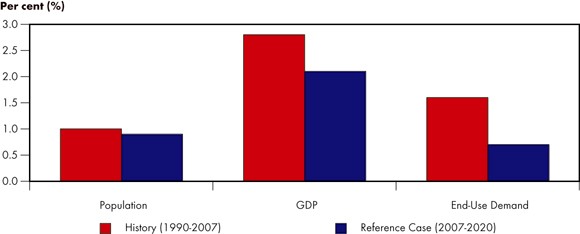
Notwithstanding the factors mentioned above, the overarching conclusions from the 2007 Reference Case remain intact. Canadians can expect the energy markets to function well with energy prices balancing demand and supply. Energy from conventional fossil fuels is expected to be the dominant source of supply, although non-conventional sources will continue to gain share. The integration of energy, environment and economy will continue to grow and Canadians will increasingly include environmental considerations in their decision making.
Chapter 1. Introduction
- Canada's Energy Future: Reference Case and Scenarios to 2030 was released in November 2007. The report examined possible energy futures that might unfold for Canadians up to the year 2030. This included a baseline projection, called the Reference Case, which examined energy supply and demand trends to the year 2015 based on macroeconomic outlook, energy prices, and government policies and programs in place at that time. In addition, three scenarios, each with its own internally consistent set of assumptions were considered.
- This report is an update to and extension of the NEB's 2007 Reference Case analysis. Major changes have occurred since the last report, including a rapid run-up and then decline in global oil prices; a global financial crisis and resulting global economic slowdown, and; enactment of new energy and environment policies. This update includes both Low and High energy price Cases to provide broader perspective, due to the ongoing volatility of energy prices[2]. This report extends the Reference Case analysis timeframe out to 2020[3].
[2] Note that the high and low price cases considered in this Update are sensitivities rather than scenarios, which was the methodology employed in the 2007 report. The key difference is that sensitivity isolates the affect of a change in one variable on the key outputs whereas scenario analysis considers the interactions of multiple variables at the same time (e.g., changes in prices, economic growth, technology development, government policies, geopolicitics, consumer behaviour, etc.). Both provide ways of analyzing uncertainty.
[3] In this report, the last year of history varies depending on availability of statistical information, for example the last historic year for electricity supply information is 2006, end-use demand data is 2007, and oil and gas supply data is 2008. - The following chapters discuss key changes influencing the Reference Case analysis and highlight Canadian energy demand and supply trends. Data tables can be found in the appendices, which are available on the NEB website[4].
Chapter 2. Energy Context
- The Canadian energy market does not operate in isolation. It is strongly affected by global and regional energy pricing trends, macroeconomic trends, developments in technology, and changes to government programs and policies. This chapter provides important background information to help understand the results of the 2009 Reference Case Scenario. Additional background information can be found in the NEB's 2008 Canadian Energy Overview, available on the NEB website.
Oil and Gas Markets - Global and Regional Trends
Crude Oil
- Over the last decade, oil prices rose and fell dramatically in response to changes in global economic conditions. Between 2000 and 2007, global crude oil prices experienced significant growth. This was supported by increased global energy demand and tight energy supplies. Many emerging and developing economies, such as India and China, experienced sustained economic growth rates of over 7.0 per cent per year between 2000 and 2007, contributing to the rapid increase in global fuel demand. At the same time, global crude oil supply struggled to keep pace with rising demand due to maturing conventional oil resources and geopolitical tensions which limited access to some global supplies (e.g., economic and political nationalism, local opposition to development).
- At the beginning of 2008, oil prices broke the US$100/bbl mark for the first time ever. Prices continued to escalate throughout the first half of the year reaching an all-time high of US$147/bbl in July. Although higher prices led to decreased demand in OECD countries, many emerging economies continued to experience demand growth, partly due to fuel subsidies that insulated consumers from the full price effect. In the face of this rising demand, global supplies remained tight, which supported upward movement in crude oil prices. These supply and demand fundamentals were compounded by higher returns on commodities, which led to investment money flowing into the oil market, increasing the volatility of oil prices. The decline in the value of the U.S. dollar also contributed to higher oil prices.
- The latter half of 2008 saw oil prices swing in the opposite direction as the global effects of the U.S. housing market collapse and financial crisis became apparent. Businesses had trouble accessing credit and consumers' wealth decreased as a result of declining housing prices, falling equity markets and increasing job losses. These factors shook confidence levels and resulted in reduced consumption and investment.
- Countries are more integrated today than any time in the past through trade and financial flows. The factors that pushed the U.S., the world's largest economy, into recession have had a domino effect around the globe. Despite some beliefs early in the global economic downturn that emerging and developing economies might escape the effects of the U.S. recession (because of the relative size and strength of their domestic demand and increased importance of interregional trade in Asia), the world is experiencing the most synchronous economic recession in 50 years[5].
[5] International Monetary Fund, World Economic Outlook, April 2009.
- The decline in global economic activity has meant a reduction in energy demand growth. By the end of September 2008, global crude inventories were building and oil prices were falling. Over the course of three meetings in late 2008, OPEC agreed to cut oil production by 670 thousand m³/d (4.2 MMb/d), in an attempt to halt falling oil prices. However, worsening economic conditions and continued inventory builds meant that the WTI near-month contract ended the year at US$45/bbl. In Canada, the lower energy prices reduced company budgets, leading to reduced drilling and postponement of Canadian energy projects. The first quarter of 2009 saw global crude oil prices stabilize around US$40/bbl. By May 2009, average prices had increased to the US$60/bbl level.
- The near and long-term futures of global crude oil prices are dependent on global economic recovery. Government and central banks around the world are enacting fiscal and monetary policies to address the financial crisis and global economic slowdown. However, the length and depth of the global economic recession and the pace of economic recovery continues to be an unknown factor. Projections[6] suggest that overall global economic growth will fall by 1.7 per cent in 2009. The first two quarters of 2009 show negative growth and a recovery beginning in the last two quarters of the year. The global economy will continue to slowly recover throughout 2010 with a projected growth rate of 2.3 per cent. This compares to average annual economic growth of over 3.0 per cent since the year 2000.
[6] World Bank, Global Economic Prospects 2009, March 30 2009.
Natural Gas
- In natural gas markets, the economic slowdown significantly reduced industrial demand at the same time that natural gas supply in the U.S. was rising. The biggest change to North American natural gas markets since the previous Reference Case is the potential for significant increases in tight gas and shale gas production. This development is progressing rapidly in the U.S. and is beginning to get underway in Canada. Commercialization was achieved through technological advances in rock fracturing to improve gas recovery, which have opened up the potential for a vast supply of natural gas in several new regions.
- The market imbalance caused by excess supply in the face of falling demand has caused natural gas prices to fall by almost 75 per cent from the July 2008 peak of US$13.32/MMBtu and natural gas-directed drilling activity to fall by 50 per cent in 2009. Reduced drilling will eventually lead to production declines and, coupled with an increase in demand, provide a rebalancing of supply and demand that could cause prices to begin to rise in 2010. This would signal the start of the next economic cycle for natural gas with increasing drilling and growing supply and demand in 2011 and 2012.
Government Programs and Policies
- Energy and the environment are becoming increasingly interconnected. Indications suggest that North America is on the cusp of significant environmental policy changes. These changes could have a profound influence on how Canadians produce and consume energy.
- There have been a number of environmental announcements since the 2007 report at the national and international levels. The new U.S. administration is supporting the creation of federal cap-and-trade legislation. Additional details regarding Canada's GHG emissions reductions in the industrial sector, as outlined in the federal Regulatory Framework for Industrial Greenhouse Gas Emissions, have been released. Four Canadian provinces and seven U.S. states have partnered in the Western Climate Initiative, which is developing a regional carbon market cap-and-trade program[7]. There is also movement to improve vehicle fuel economy standards in North America as well as to develop a Low Carbon Fuel Standard.
[7] The participating regions are British Columbia, Manitoba, Ontario, Quebec, Arizona, California, Montana, New Mexico, Oregon, Utah and Washington.
- At the provincial level, there have been several policy directives put in place. This includes the BC Energy Plan, Alberta's Climate Change and Emissions Management Amendment Act and Manitoba's Beyond Kyoto. As well, further details surrounding existing programs and policies have been announced. Most provinces in Canada now have an energy efficiency mandate.
- These policy directives are noteworthy and provide an outlook of potential future directions. However, many of these policies are not yet at the program stage. The 2009 Reference Case Scenario includes only current government programs in its analysis, therefore the evolving policies, such as those mentioned above, have not been quantitatively analyzed. Polices such as cap and trade programs and low carbon fuel standards have been commented on within this report in the emerging trends discussions. This aligns well with the standard methodology employed by other energy groups, such as the U.S. Energy Information Agency.
- Examples of included polices and programs are detailed in Chapter 4. These include programs such as stricter building codes, new efficiency standards for energy using equipment, regulations impacting larger use of renewables and carbon taxes in Quebec and BC. As a result, the 2009 Reference Case Scenario is exhibiting some of the features of the Triple E scenario considered in the 2007 report[8].
[8] The Triple E scenario was one of the potential energy outcomes considered and in this scenario society was increasingly attempting to balance energy, environment and economic factors.
Chapter 3. Key Drivers
- This report considers three alternate price cases. The 2009 Reference Case Scenario reflects a moderate view of future energy prices collected through stakeholder consultations in early 2009. The NEB also considers cases where crude oil and natural gas prices are assumed to be either lower or higher. These alternate analyses are referred to as the Low Price Case and the High Price Case.
Energy Prices
Crude Oil Prices
- In the 2009 Reference Case Scenario, the WTI crude oil price is assumed to average roughly US$50/bbl in 2009. The price is assumed to increase with the recovering global economy, reaching US$90/bbl by 2020 (US$2008/bbl), compared to the 2007 Reference Case, which assumed constant crude oil prices averaging around US$50/bbl[9]. The 2009 price outlook is influenced by global energy demand and supply fundamentals that suggest an increasingly tight crude oil market in the long-term, supporting real growth in the oil price. Income and demand growth in emerging economies after 2009, along with the increasing difficulty and cost to develop crude oil pools are the major factors.
[9] Prices are reported in US$2008 unless otherwise specified.
- The WTI crude oil price in the Low Price Case reaches just above US$60/bbl in 2020 and the High Price Case grows to just over US$120/bbl.
Figure 3.1 - West Texas Intermediate Crude Oil Price at Cushing, Oklahoma, Reference Case Scenario and Price Cases
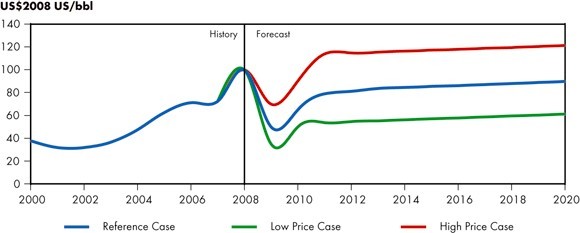
Natural Gas Prices
- After declining significantly in 2009, the Henry Hub price of natural gas in the 2009 Reference Case Scenario gradually rises from US$6.70/MMBtu in 2011 to US$7.50/MMBtu by 2020. These prices are slightly below the US$7.50/MMBtu assumed in the 2007 Reference Case[10], reflecting a greater availability of tight gas and shale gas supply.
[10] Specifically, $7.00 in $2005 US/MMBtu as prices were reported in 2005 dollars in the 2007 report.
- Natural gas prices are primarily determined on a continental basis as a result of the integrated nature of the North American natural gas demand and supply market, and import capacity and liquidity in the global liquefied natural gas (LNG) market. Traditionally, natural gas prices have moved in relation to crude oil prices, although usually at a slight discount to the 6:1 energy-equivalent basis, resulting in a natural gas to oil price ratio of roughly 10:1 (oil prices in $/barrel relative to natural gas prices in $/MMBtu). This relationship has not held over the last few years and there is uncertainty about the future price relationship.
- In the Low Price Case, the Henry Hub natural gas price rises from US$5.10/MMBtu in 2011 to US$5.50/MMBtu in 2020. In the High Price Case, the Henry Hub price rises from US$8.30/MMBtu in 2011 to US$11.00/MMBtu in 2020.
Figure 3.2 - Henry Hub Natural Gas Price at Louisiana, Reference Case Scenario and Price Cases
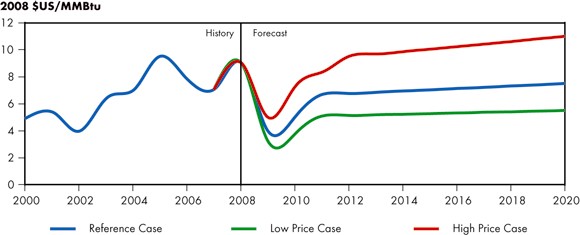
Electricity Prices
- Electricity prices are determined in regional markets. Consumer prices for electricity are composed of generation, transmission and distribution costs. Prices are lowest in the hydro-based provinces (British Columbia, Manitoba, and Quebec), which benefit from a high proportion of low-cost heritage assets, such as hydro-generating stations that are often many decades old and whose capital costs are largely amortised.
- Prices in most jurisdictions are based on the cost of providing service to consumers including a regulated rate of return on generation, transmission and distribution assets. Costs are approved by provincial and, in some cases, municipal regulators. When required, the cost of new generation, usually more expensive than heritage assets, must also be approved and rolled in, resulting in higher average costs.
- This model is followed in all provinces and the territories except Alberta and Ontario. In Alberta generation costs are based on competitive wholesale markets, while Ontario is a hybrid of the two methodologies, with a blend of heritage pricing for coal, nuclear and hydro plants and market-based prices for new generation.
- Typically, prices tend to be higher for residential customers and lower for large volume commercial and industrial customers, reflecting the cost of serving these markets. In addition, large customers may have access to power at lower costs than can be obtained from the provincial or municipal electric utility. This requires open access to transmission systems (or wholesale access). All provinces have some form of wholesale access.
- Similar to the 2007 Reference Case, electricity consumers continue to face upward pressure on electricity rates in the 2009 Reference Case Scenario. This is mainly driven by the development of higher-cost generation resources and planned improvements to transmission systems.
Coal Prices
- Canadian coal prices for power generation vary substantially by region, with prices in Western Canada being generally lower, reflecting the cost of integrated mining and power generation (mine mouth power plants). Prices of coal imported to Nova Scotia, New Brunswick and Ontario reflect the competitive international market. Western Canadian coal is not usually competitive in Ontario, after taking into account quality differences and transportation costs.
- In the period to 2020, coal prices are assumed to remain approximately constant at levels experienced in 2007. Competitive pressures and productivity increases in mining and rail transportation prevent coal prices from increasing with gradually rising oil and gas prices in the Reference Case Scenario. There is no assumption of an incremental carbon price in the Reference Case Scenario.
Economic Growth
- Economic projections are a key driver for the Reference Case Scenario projections. Macroeconomic variables including economic growth, gross output, inflation and exchange rates are used to develop the energy demand and supply outlooks.
- In the 2009 Reference Case Scenario, Canadian average real GDP growth is 2.1 per cent per year over the outlook period. Long-term economic growth is dependent on population, labour force and productivity assumptions. This rate of growth is slower than in the previous Reference Case Scenario outlook, reflecting more conservative assumptions for productivity growth rates (1.1 per cent versus 1.6 per cent).
- The current economic recession is reflected in this analysis. In 2009, economic growth is estimated to be -2.6 per cent. Growth is assumed to rebound to + 2.6 per cent in 2010. As in many past business cycles, the recession is assumed to be followed by rapid, recovery-stage growth. It then returns to trend growth expectations in 2013 consistent with the demographic and productivity assumptions in this analysis.
- Changes to commodity prices are expected to influence economic conditions in Canada as well as the exchange rate. In recent years, as global crude oil prices increased the Canadian dollar has appreciated compared to the U.S. dollar and as global crude oil prices decreased the Canadian dollar has depreciated.
- In the Low Price Case, consumer energy costs are lower, both directly (e.g., transportation fuels) and indirectly, for products which use energy as an input (e.g., transportation of goods to market, etc.). These lower costs encourage consumption. In addition, the manufacturing sector, concentrated in central Canada, faces lower input costs and enjoys more favourable trading terms because the exchange rate is assumed to depreciate with lower global crude oil prices. This helps spur economic growth in these sectors. Although consumers and industries in oil and gas producing provinces benefit from lower energy prices, overall economic growth is dampened due to lower energy prices, which reduce oil and gas production. The opposite effect tends to occur in the High Price Case.
- The net effect is a relatively small difference in economic growth at the national level. Canadian economic growth is projected to be 2.0 per cent and 2.3 per cent in the Low Price Case and High Price Case, respectively.
Key Uncertainties to the Outlook
- Future global crude oil prices continue to be a key uncertainty. Some of this risk has been tempered by examining a Low Price Case and High Price Case.
- There is an evolving natural gas and crude oil price relationship. Until mid-2007, natural gas prices in North America often moved within a band defined at the upper end by the price of distillate fuel oil, such as heating oil, and at the lower end by residual fuel oil, which is used to heat boilers in industrial and power generation applications.
- A key rationale given for this observed relationship was the ability of industrial and power generation facilities with dual fuel capability to readily switch between natural gas and residual fuel oil depending on which fuel had the lower price. Over the years, the amount of this dual-fuel capable capacity has eroded to relatively insignificant levels due to several factors including high maintenance costs, environmental restrictions and siting issues, raising the possibility that the observed relationship was becoming more of a behavioural artifact than a physical reality.
- Since mid-2007, natural gas prices have often tracked US$3.00 to $4.00/MMBtu below the residual fuel oil price, and closer to a delivered coal price to eastern power utilities, including allowances for emissions permits. Such behaviour has given rise to speculation that the lower boundary for natural gas prices has become the coal price, or effectively a "coal floor". The rationale for this view is the scale of the coal-fired generation fleet in the U.S., which is large enough[11] that even a minor displacement of coal units through the dispatching of natural gas-fired plants would create enough additional natural gas demand to keep natural gas prices from falling further.
[11] Roughly 1 billion short tons of coal are consumed in U.S. power generation per year (Energy information Administration) equivalent in energy content to at least 31 Tcf or 85 Bcf/day of natural gas. This is more than the roughly 70 Bcf/d combined total of U.S. and Canadian natural gas production.
- The growing contribution to natural gas supply from tight gas and shale gas is helping to reduce concerns of inadequate future supply and has the potential to expand the traditional discount that North American natural gas prices have received relative to world oil prices. The relative abundance of tight gas and shale gas could impact LNG imports, frontier projects, and exports from Canada to the U.S.
Reportedly, U.S. shale gas production can be economically produced at market prices in the US$3.50/MMBtu to US$4.00/MMBtu range. As the contribution of shale gas to overall production increases, more of the highest-cost conventional gas could be displaced, effectively shifting natural gas costs lower.
The relatively large scale of shale gas potential in North America may keep natural gas prices down. In contrast, there is a commonly held view that crude oil costs and prices may move higher. Upward influences on crude oil costs include increasing resource nationalism, increasing technical challenges associated with deep water and sub-salt prospects offshore, higher operational and environmental costs associated with oil sands developments, and demand growth for petroleum in developing countries. - Since the influence of these factors on natural gas prices is unclear at this point, the approach taken in this analysis is to plot an independent course for natural gas prices based on North American market fundamentals such as cost, supply and demand. Should price relationships with other fuels become more apparent at a future time, these can be adopted in future versions of this analysis.
- The current economic uncertainty also poses a risk to the 2009 Reference Case Scenario. The length and depth of the current Canadian and global economic recession are unknown, as is the pace of economic recovery. If these factors evolve differently than assumed here it will influence energy markets and the reference case projections.
- Over the outlook period, there are likely to be significant unpredictable events beyond the realm of normal expectations, such as technological breakthroughs. These unforeseeable events are not included in this analysis.
Chapter 4. Energy Demand Outlook
- Total secondary (end-use) energy demand in Canada is expected to increase with increases in population and economic growth (Figure 4.1). However, energy demand growth rates are projected to slow compared to history and compared to the NEB's 2007 projection (Figure 4.2). End-use energy demand is estimated to increase at 0.7 per cent per year. This is primarily due to slower economic growth assumptions in the 2009 Reference Case Scenario.
Figure 4.1 - Canadian Total Secondary Energy Demand, Reference Case Scenario and Price Cases

Figure 4.2 - Comparison of 2009 Reference Case Scenario and 2007 Reference Case End-Use Demand
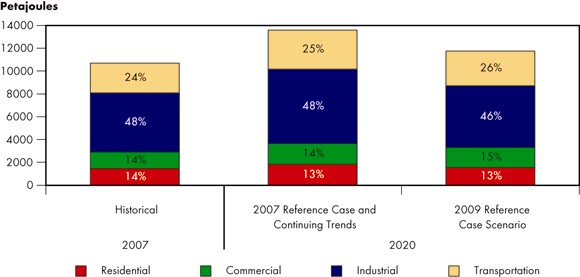
- Another important factor contributing to lower energy demand expectations are newly included provincial and federal energy demand management and environmental programs. This includes stricter building code requirements in various provinces, new minimum energy efficiency standards for energy using equipment, new standby limits on common household items and phase-out of inefficient lighting in Canada.
- Greenhouse gas emissions from energy are a function of energy supply and demand decisions. As demand continues to increase, GHG emissions are expected to increase as well. However, the slowing growth in energy demand as a result of these newly included programs will result in slowing growth in GHG emissions. Further, as the environmental policies mentioned earlier take shape as programs, this growth rate will decrease further. Observed trends in energy supply, including use of greener fuels in electricity, will also result in a decline in the growth rate of GHG emissions. These combined trends as depicted in the 2009 Reference Case Scenario are expected to slow the growth in GHGs as compared to both history as well as NEB's 2007 projections.
- Historically, Canadian energy intensity, which is the amount of energy used per dollar of GDP generated, has fallen. This measure provides an indication that Canada is using energy more efficiently over time. Energy intensity continues to fall over the outlook period, with an average annual reduction of 1.3 per cent per year.
- Changes to energy prices and economic growth impact end-use energy demand. In the Low Price Case, the annual average end-use energy demand growth rate is 1.2 per cent per year (Figure 4.1). On the other hand, annual average end-use energy demand for Canada in the High Price Case is reduced to 0.3 per cent per year. Higher energy prices provide the impetus to consumers to reduce energy consumption. The opposite effect occurs in the Low Price Case.
- As discussed in the Key Drivers chapter, higher energy prices also impact Canadian economic conditions. This in turn influences energy demand trends. In the Low Price Case, economic growth is stronger in central Canada as a result of more favourable energy input costs and trading conditions compared to the oil and gas producing provinces. As a result, central Canadian energy demand grows stronger in the Low Price Case than in the other cases considered. The opposite effect generally occurs in the High Price Case where economic development and therefore energy demand is spurred by higher energy prices in oil and gas producing provinces.
Energy Consumption by Sector[12]
[12] Note that the 2009 outlook for energy demand growth by sectors is not directly comparable to the 2007 Energy Future's Reference Case outlook due to changes in sector definitions. These changes were motivated by a desire to align various energy demand data sets in Canada. The difference in total historic end-use demand is less than one per cent in any given year but sectoral differences are larger.
Residential Sector
- The residential sector accounts for energy consumed by Canadian households, including energy for space and water heating, air conditioning, appliances and other end-use energy devices (e.g., televisions, computers, etc.).
- In the year 2007, Canadian residential energy demand was 1 448 PJ and accounted for about 14 per cent of total end-use energy demand. Over the outlook period, residential sector energy demand grows at an average rate of 0.5 per cent per year reaching 1 552 PJ by 2020. The fuel mix of residential demand changes little over the outlook period.
- The rate of growth in residential sector energy demand in the 2009 Reference Case Scenario is slower than in the 2007 Reference Case and historic data due to slowing economic conditions. Residential energy demand growth also slows as a result of government policies and changing consumer values.
- Programs included in the 2009 Reference Case Scenario that were not included in the 2007 Reference Case consist of stricter building code standards in British Columbia, Ontario and Quebec. New furnace and boiler efficiency standards improve the energy intensity of all new homes nationally. Also, a new standard to phase out inefficient lighting starting in 2012 has been applied across Canada. The number of home electronic goods that were formerly unregulated, and are now under minimum energy performance guidelines, has increased. In addition, many of these home electronics begin to come into the market with new standby power restrictions, which can significantly reduce unit energy demand. The analysis also considers the impact of complimentary programs such as energy retrofit, rating and labeling initiatives, purchasing incentive programs, conservation promotion and on-site renewable energy. The ecoENERGY initiative for solar thermal and geothermal energy has partners in several provinces. In addition, many regions now have provisions in place that allow small, renewable energy systems to connect to the provincial grid.
- Natural gas and electricity make up the majority of demand in this sector (Figure 4.3). Impressive improvements in energy efficiency in the residential sector for space heating and major appliances have been countered by increased energy demand from increasing home size, preferences for air conditioning, and more electronic goods. These factors are evident in the historical trend showing ever-increasing consumption per household, particularly electricity demand. Over the outlook period, electricity demand growth is projected to slow from historic trends but it still remains the fastest growing energy source in the residential sector influenced primarily by continued growth in electronic goods. Policies specifically addressing a couple of rampant growth categories (e.g., standby power), along with consumer purchasing decisions, impact the historical trend.
Figure 4.3 - Residential Sector Energy Demand by Fuel, Reference Case Scenario
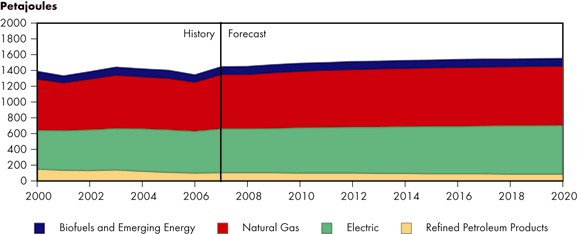
- Regional availability of fuel, energy prices, and end-use demand determines the mix of fuel used across Canada. In Atlantic Canada, residential demand has been met with electricity, oil and biomass as natural gas was historically unavailable. Hydro-rich provinces, such as Quebec, Manitoba, and British Columbia, rely more heavily on electricity to meet residential energy demand than other provinces, as electricity prices tend to be competitive with other fuels. Similarly, Alberta and Saskatchewan rely more heavily on natural gas than other regions as there is an abundant supply of this fuel in the region.
- In recent years, expanding natural gas infrastructure in Nova Scotia and New Brunswick has allowed natural gas to penetrate residential, commercial and industrial sectors. This is expected to continue in the future. In the residential sector, natural gas demand is projected to account for two per cent of Nova Scotia residential demand and three per cent of New Brunswick demand by 2020.
- In the Low Price Case, average residential energy demand growth increases to 0.7 per cent per year. In the High Price Case, average residential energy demand growth falls to 0.3 per cent per year.
Commercial Sector
- The commercial sector is a broad category that includes offices, retail, warehousing, government and institutional buildings, utilities, communications, and other service industries. It also includes energy consumed by oil and gas pipelines and street lighting. Generally, end-uses are similar to the residential sector and include space heating and cooling, water heating, lighting, and electrical plug-load.
- In the year 2007, Canadian commercial energy demand was 1 471 PJ and accounted for about 14 per cent of total end-use energy demand. Over the outlook period, commercial sector energy demand grows at an average rate of 1.4 per cent per year, reaching 1 769 PJ by 2020 (Figure 4.4). The share of commercial demand increases slightly to 15 per cent of total end-use energy demand over the outlook period.
Figure 4.4 - Commercial Sector Energy Demand by Fuel, Reference Case Scenario
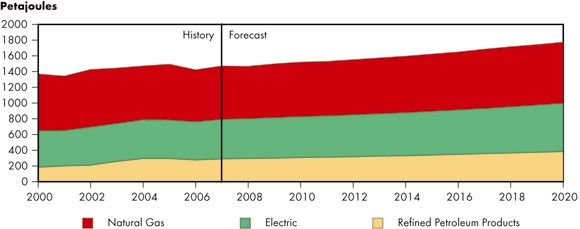
- Overall, growth in this sector is slightly higher than in the 2007 Reference Case due to a stronger emphasis on service sector growth compared to the goods producing sector in the macroeconomic outlook. However, this rate of growth in the commercial sector is slower than its historical rate. As with the residential sector, a combination of factors converge to support a more aggressive improvement in energy efficiency than in the past, including ongoing higher prices and government initiatives.
- Energy-related policies in the 2009 Reference Case Scenario that were not in the 2007 Reference Case include new provincial building codes in several provinces addressing energy consumption in commercial buildings. These codes are primarily related to insulation and heating/ventilation and air conditioning minimum standards and call for a 25 per cent improvement in energy demand over the Model National Energy Code for Buildings (1997) level. British Columbia has endorsed one of the most aggressive commercial building standards in North America.
- All provinces would see, as a minimum, gains from the updated federal equipment standards, including minimum boiler efficiency and packaged heating/cooling units as well as improvements in lighting efficiency. In addition, federal and provincial programs for commercial building retrofits are assumed to stay in place for the full Reference Case Scenario period.
- In the Low Price Case, average commercial energy demand growth increases to 1.6 per cent per year. In the High Price Case, average commercial energy demand growth falls to 1.2 per cent per year.
Industrial Sector
- The industrial sector includes manufacturing, forestry, fisheries, agriculture, construction, and mining. The majority of industrial energy demand is found in a handful of energy-intensive industries, such as iron and steel, aluminium manufacturing, cement manufacturing, chemicals and fertilizers, pulp and paper, petroleum refining, and oil and gas extraction[13].
[13] In 2007, energy-intensive industries accounted for about 80 per cent of industrial energy demand. Industries outside of energy-intensive industries, such as light manufacturing, agriculture, forestry and construction, each account for a relatively small proportion of industrial energy demand, but taken together account for about 20 per cent.
- The industrial sector makes up the largest share of the energy use in Canada accounting for about 48 per cent of energy demand in 2007. By 2020, the industrial share decreases to 46 per cent reflecting slowing economic growth in the Canadian goods producing sector. Overall, industrial sector growth is slow over the Reference Case outlook reaching 5 381 PJ in 2020 (Figure 4.5).
Figure 4.5 - Industrial Sector Energy Demand by Fuel, Reference Case Scenario
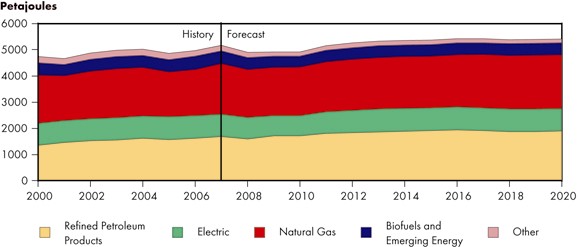
- Energy-intensive industries in Canada are mature industries, facing increasing global competition and higher Canadian exchange rates. An exception to the overall industrial energy demand trend is the oil and gas industry. The strength of this industry drives much of the industrial sector energy demand growth over the outlook. Oil sands operations are energy-intensive, requiring significant amounts of natural gas, as well as other fuels, such as refined petroleum products, still gas, petroleum coke and electricity.
- Over the past decade, the energy efficiency in oil sands operations has improved on the order of one per cent annually. In the Reference Case Scenario, this rate of improvement is applied to the natural gas requirements to the year 2020. In addition, the adoption of alternative fuels and processes are considered, such as bitumen gasification as well as the application of THAITM in situ recovery process and solvents to reduce thermal energy requirements.
- In the Reference Case Scenario, total purchased natural gas requirements for oil sands, excluding on-site electricity requirements, increase from 245 PJ to 537 PJ by 2020[14].
[14] In terms of volume, this equates to an increase from 17 million m³/d (0.6 Bcf/d) in 2007 to 40 million m³/d (1.4 Bcf/d) in 2020.
- A key challenge in forecasting energy demand change in the industrial sector arises from the extent and direction of environmental legislation. At the time of this report preparation, there was gaining momentum in North America for a market system for GHG emissions reductions, specifically a cap-and-trade program. Impending decisions by government and industry are likely to impact the amount and type of energy used by the Canadian industrial sector. However, legislation is still evolving and therefore potential impacts from any future decisions in this area are not considered in the 2009 Reference Case Scenario.
- In the Low Price Case, average industrial energy demand growth is 0.6 per cent per year. In the High Price Case, average industrial energy demand growth falls to -0.1 per cent per year.
Transportation Sector
- Transportation sector demand includes passenger, freight and off-road transportation for on-road vehicles as well as air, rail and marine travel. Total transportation energy demand accounts for 24 per cent of end-use energy demand in 2007 and changes marginally over the outlook period.
- Transportation sector energy demand is projected to increase by an average of 1.2 per cent per year. Similar to the other sectors examined, the 2009 Reference Case Scenario for transportation sector energy demand is slower compared to historic growth rates as well as the 2007 Reference Case projection. This result is due to higher fuel prices, slowing economic conditions, more rapid uptake of energy-efficient technology, such as hybrid electric vehicles, as well as changes to consumer behaviour and purchasing decisions.
- Passenger transportation comprising on-road vehicles, transit, and air travel continues to be the largest component of Canadian transportation energy demand accounting for 55 per cent and 52 per cent of transportation demand in 2007 and 2020, respectively (Figure 4.6). Freight transportation demand includes on-road trucking, rail, marine and some air and is expected to continue to grow more rapidly than passenger transportation demand over the outlook period, averaging 1.8 per cent per year. Off-road transportation demand is defined as all-terrain vehicles, lawnmowers, and miscellaneous small equipment and accounts for less than five per cent of transportation energy demand.
Figure 4.6 - Transportation Sector Energy Demand by Mode, Reference Case Scenario
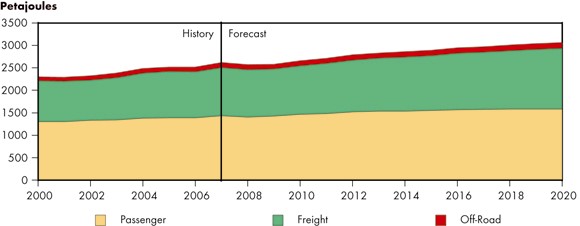
- The transportation sector is dominated by refined petroleum products, primarily gasoline and diesel fuel (Figure 4.7). Refined petroleum products continue to meet the majority of energy demand requirements in the transportation sector. With the exception of ethanol, supported by provincial fuel standards in Saskatchewan, Manitoba and Ontario, the market share of alternative fuels (e.g., propane, natural gas and electricity) remains static in this outlook.
Figure 4.7 - Transportation Sector Energy Demand by Fuel, Reference Case Scenario
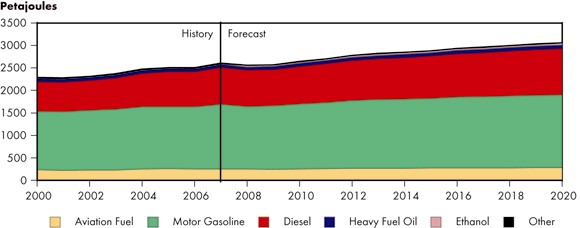
- There is tremendous interest in hybrid electric vehicles, plug-in hybrid electric vehicles, and full electric vehicles. In the Reference Case Scenario, hybrid vehicles continue to penetrate the transportation market and improve passenger transportation energy demand intensity by slowing gasoline consumption. However, they do not influence the electric demand outlook in the transportation sector as hybrid vehicles have a self-contained battery and engine system and do not use grid power.
- The potential for alternative vehicle technologies to make significant in-roads into the transportation sector depends largely on the economics, consumer preferences and rates of vehicle turnover. Although attitudes can change rapidly, it takes time for new technologies to permeate the market. It is assumed that even with increases in market penetration, the share of plug-in hybrid and full electric vehicles in the total vehicle market in 2020 would not significantly alter the sector's fuel mix.
- It is important to note that it is a dynamic time for the automotive sector in North America. At the time of writing, the automotive industry is in a state of significant change as a result of the global economic recession. Coinciding with the changes in the industry itself are developments in government policy that could reshape transportation sector energy demand. Proposals for more stringent fuel efficiency standards on motor vehicles have been proposed at the U.S. federal level and also at the state level. The Canadian federal government and a number of provinces in Canada have also announced their intent to regulate fuel consumption of motor vehicles. It is possible that Canada's regulations will align with the U.S. federal and/or California State regulations given the highly integrated nature of the North American automotive industry.
- In addition, legislation to reduce the carbon intensity of transportation fuels and to advance alternative fuels for the transportation sector are being developed in California. This policy is also examined at the national level in the U.S. and at the provincial level in Canada. Both the Ontario and British Columbia governments have indicated that they will adopt California's Low Carbon Fuel Standard.
- Sufficient details on the future of vehicle fuel economy standards and the low carbon fuel intensity standards for Canada are not available to quantify for the 2009 Reference Case Scenario. However, the expectation is that these standards could lead to improved average fuel economy of the vehicle fleet in Canada and changes to the vehicle fuel mix. This is a rapidly evolving area. These programs will be included in future analysis as details become available.
- In the Low Price Case, average transportation energy demand growth increases to 2.1 per cent per year. In the High Price Case, average transportation energy demand falls to 0.6 per cent per year.
Key Uncertainties to the Outlook
- One of the biggest challenges of this report period is the implementation of several key polices at the federal level that are not yet final. Although in the development stage, they are lacking in sufficient detail to be properly modeled in the Reference Case Scenario.
- However, the expectations are that these policies will influence the absolute level of energy demand as well as the fuel mix. Changes in the absolute level of energy demand will depend on the sector and sub-sectors considered. Policies designed to improve energy efficiency, such as vehicle efficiency standards, will reduce energy demand. However, the full benefit of these improvements in energy efficiency might not materialize as a result of the rebound effect. The rebound effect means the tendency for consumers to increase utilization of energy using devices when efficiency improves due to reduced operational costs (e.g., increase travel due to improved vehicle efficiency). On the other hand, technological solutions to reduce GHG emissions, such as CCS, can increase energy demand requirements concurrently with reduction of GHG emissions as additional resources are required to capture, transport and store CO2.
- There is very little fuel switching projected over the outlook period in the 2009 Reference Case Scenario. Changes in fuel demand are slow to occur, in large part due to the large stock of existing energy using devices in the economy. However, upcoming legislation could encourage faster development and/or adoption of alternative and renewable fuels resulting in higher consumption of these fuels and reduced demand for more conventional fuels than presented in this analysis.
Chapter 5. Crude Oil Supply Outlook
Resources
- Canada is endowed with vast oil resources. These resource numbers are dominated by bitumen resources, which account for 98 per cent of total remaining crude oil reserves. The Alberta Energy Conservation Board reports remaining reserves of crude bitumen of 27.5 billion cubic metres (172.9 billion barrels), at year-end 2007. Crude bitumen deposits also exist in the province of Saskatchewan, and are in the early stages of delineation, but no official resource estimates are yet available.
- In the Western Canada Sedimentary Basin (WCSB), including Norman Wells and Cameron Hills in the Northwest Territories, remaining reserves of conventional crude oil amount to 451.6 million cubic metres (2.85 billion barrels)
- Statistics for Eastern Canada are dominated by the Newfoundland and Labrador Offshore, with remaining reserves of 161.2 million cubic metres (1.02 billion barrels)
- A detailed breakdown of Canada's remaining crude oil reserves is provided in Appendix 3.
Crude Oil Supply Outlook
- Figure 5.1 illustrates the oil production outlook for all of Canada, for all types of crude. Figure 5.2 shows a comparison between the 2007 Reference Case and the 2009 Reference Case Scenario. The difference between the projections is indicative of the impact of the current economic conditions, which decreased global crude oil demand and energy prices thereby reducing the economics of Canadian production. The gap widens to 125 thousand m³/d (790 Mb/d) by 2015, primarily due to lower projected oil sands production, but also due to shifting the onset of the Hebron Field, situated in the Newfoundland and Labrador offshore region, from 2013 to 2017. This latter date reflects the project proponents' decision to proceed, after extended negotiations with the province. The gap narrows to 40 thousand m³/d (250 Mb/d) by 2020 as growth accelerates in the latter part of the projection. By 2020, production reaches 608 thousand m³/d (3.8 million b/d).
Figure 5.1 - Total Canadian Oil Production, Reference Case Scenario
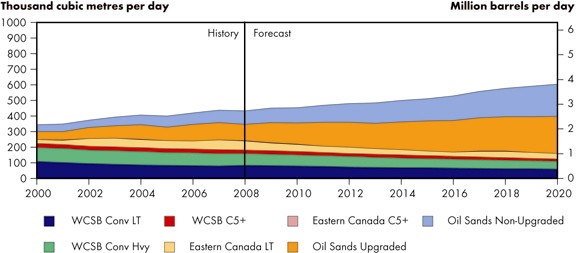
Figure 5.2 - Comparison of 2009 Reference Case Scenario and 2007 Reference Case Crude Oil Supply Outlook
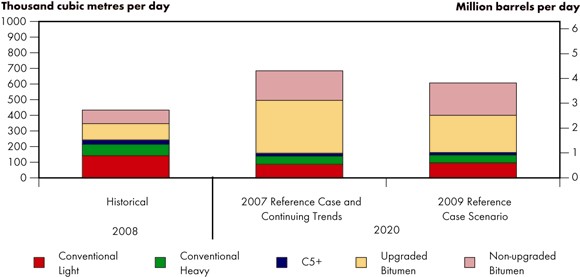
- WCSB conventional oil production continues a well-established historical decline of about three per cent per year, consistent with a maturely developed basin. In the near-term, for 2009 and 2010, sharply lower oil prices than experienced in the first half of 2008 and the corresponding reduced drilling effort serve to decrease oil production levels. However, this effect has been moderated by the success of the Bakken play, and the Weyburn and Midale CO2 Enhanced Oil Recovery (EOR) projects in southeast Saskatchewan.
- As well, it is assumed that initiatives by the provincial and federal governments to promote CCS will lead to the construction of facilities, including CO2 pipelines, which will make available additional quantities of CO2 in the latter part of the forecast. Some 16 million m³ (100 million barrels) of EOR recovery is added over the projection period related to this additional source of CO2. By 2020, conventional production declines to 111 thousand m³/d (700 Mb/d), about 14 thousand m³/d (90 Mb/d) above the 2007 Reference Case projection.
- For Eastern Canada, the three major producing fields offshore Newfoundland and Labrador are in decline, but this decline is moderated by the addition of several satellite fields, starting in 2010, as well as the larger Hebron field in 2017. In the 2009 Reference Case Scenario, production declines to 33.6 thousand m³/d (212 Mb/d) in 2020.
- The assumption that a large field, of 80 million m³ (500-million barrel) size, will be discovered and be in production by 2019, is no longer included in the Reference Case Scenario, and is applied only in the High Price Case. This would result in Eastern Canada production of 57.2 thousand m³/d (360 Mb/d) by 2020.
- Rapidly escalating capital costs to build oil sands projects, followed by the global economic downturn and freeze-up of credit markets, led to the postponement of numerous planned oil sands projects by the end of 2008. Those projects that were already well underway and scheduled to be completed in 2009 and 2010 are expected to be completed, but most other projects will be delayed until economics improve. The production projection is expected to flatten somewhat after 2010. Growth rates increase after the 2014 to 2015 timeframe, in conjunction with improving oil prices. Compared to the 2007 Reference Case, this projection has oil sands production lower by 108 thousand m³/d (680 Mb/d) by 2015. By 2020, this gap is reduced to 80 thousand m³/d (504 Mb/d) and total oil sands production is 445 thousand m³/d (2.8 million b/d) (Figure 5.3).
Figure 5.3 - Oil Sands Production, Reference Case Scenario
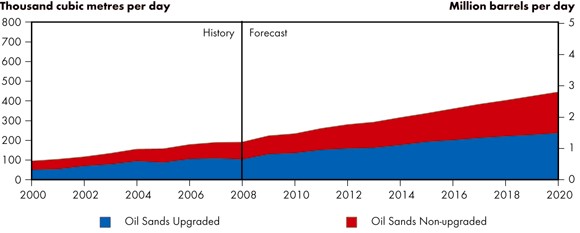
- Many of the project postponements announced in the last year involved upgraders, which convert bitumen into synthetic crude oil, either stand-alone third party "merchant upgraders", or part of integrated mining and upgrading projects. These delays mean that a larger proportion of the oil sands production will not be upgraded in Alberta. By 2020 about 54 per cent of bitumen will be upgraded in Alberta, compared to 65 per cent in the 2007 forecast.
- As levels of non-upgraded bitumen increase, so does the need for diluent, predominantly condensate, for blending purposes. The requirement for imported diluent is estimated to be in the order of 40 to 50 thousand m³/d (250 to 300 Mb/d) by 2020. Currently, about 10 thousand m³/d (63 Mb/d) is being imported via the west coast, and by truck and tank car from the U.S. The Southern Lights pipeline, scheduled to be in operation by 2010, has capacity of 28.6 thousand m³/d (180 Mb/d), with the capability of adding capacity when required.
- The estimates of initial capital expenditures required to build new projects and threshold prices needed to justify construction of greenfield projects assume a 30 per cent decline from last year's highs in most input costs, including material and labour.
- Estimates suggest that integrated mining and upgrading projects would cost in the order of US$80,000 to $100,000/bbl of capacity to build with an oil price of $60 to $70/bbl required to make a greenfield project economic (Table 5.1). For projects which produce non-upgraded bitumen, steam-assisted gravity drainage and cyclic steam stimulation projects, corresponding estimates would be US$30,000 to $40,000/bbl and a WTI price of $US55 to $65/bbl as a threshold price. These estimates include a 10 per cent real rate of return on investment to the project owners.
Table 5.1 - Estimated Initial Capital Expenditure and Threshold Prices for New Oil Sands Projects
| CAPEX ($C / bbl of capacity) |
Economic Threshold (WTI US$/bbl) |
|
|---|---|---|
| Mining Extraction & Upgrading | $80,000-$100,000 | $60-$70 |
| SAGD / CSS | $30,000-$40,000 | $55-$65 |
- The light/heavy differential is assumed to moderate from the 2007 Reference Case Scenario estimate, indicated by the improved demand outlook for heavy crude oil, and the weaker market outlook for synthetic crude oil in the medium term.
- In the High Price Case, production growth outpaces Reference Case Scenario growth after 2012, and is about 10 per cent greater by 2020 (Figure 5.4). This gap would be larger except for the assumption that as the oil price escalates, the operating and capital expenditure costs rise proportionately.
Figure 5.4 - Oil Production, Reference Case Scenario and Price Cases
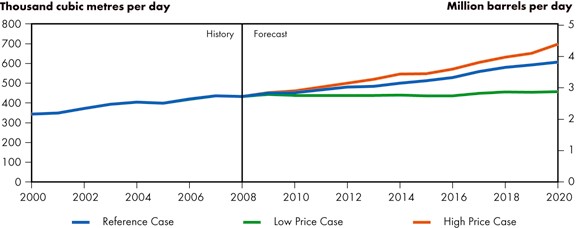
- In the Low Price Case, slight growth occurs in the near-term related to limited capacity expansion for established oil sands projects. Some growth resumes late in the forecast as industry adjusts to lower prices.
- At the lower price, production reaches 460 thousand m³/d (2.9 MMb/d) by 2020, compared with 695 thousand m³/d (4.4 MMb/d) at the high price.
Supply and Demand Balances
- Required crude oil feedstock for refining is a function of petroleum product demand. The oil refining sector in Canada relies on both domestic and imported crude to produce products Canadians demand. Canada also imports products as it is economic to do so in some regions.
- From 2008 to 2020, total Canadian refinery feedstock requirements rise by 14 per cent to 349 000 m³/d (2.2 MMb/d) in the Reference Case Scenario.
- In the High Price Case, product demand is lower, so feedstock requirements rise by only nine per cent to 333 000 m³/d (2.1 MMb/d). In the Low Price Case, where product demand is greater, requirements rise by 21 per cent to 363 000 m³/d (2.3 MMb/d).
- Exports of Canadian crude oil have been rising and will continue to respond to increases in supply from Alberta's oil sands and decreases in supply from conventional sources. Exports are surplus to domestic demand and respond directly to increases or decreases in supply.
- In the Reference Case Scenario from 2008 to 2020, exports rise 60 per cent to 447 000 m³/d (2.8 MMb/d). Both light and heavy crude register similar percentage increases in exports over the period 2008 to 2020 (Figure 5.5 and Figure 5.6). In comparison to the 2007 report, the total export volume decreases by two per cent from 455 000 m³/d (2.9 MMb/d) reflecting a lower production outlook.
Figure 5.5 - Light Crude Oil Balance, Reference Case Scenario
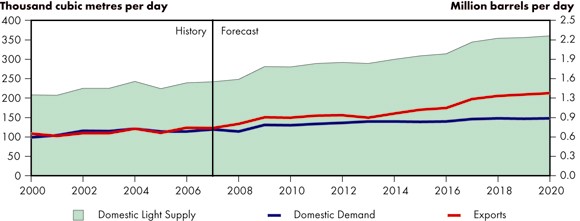
Figure 5.6 - Heavy Crude Oil Balance, Reference Case Scenario

- In the High Price Case, total exports rise by 90 per cent to 545 000 m³/d (3.4 MMb/d). The higher export volume reflects an increase in supply with prices stimulating development.
- In the Low Price Case, development decreases, resulting in lower overall Canadian supply. This is reflected in lower export volumes. In 2020 exports are 281 000 m³/d (1.8 MMb/d).
Key Uncertainties to the Outlook
- Two key areas of uncertainty that will influence the oil supply outlook presented in this analysis are economic factors and future environmental policies.
- Current under-investment in oil supply projects may lead to an oil price spike with the global economic recovery. Increased volatility of oil prices makes investment decisions to expand production more challenging.
- Construction costs might not decline as assumed, or could escalate quickly as the economy recovers. The cost of building oil sands projects is influenced to a large degree by the demand for construction materials and labour on a global basis. A robust recovery of the global economy could lead to cost inflation that could dampen the pace of oil sands expansion.
- Most of the planned bitumen upgrading projects in Alberta have been postponed. Although the Alberta government is promoting upgrading within Alberta, and has several initiatives in place, including taking bitumen-in-kind in lieu of royalty, it is difficult to predict the level of local upgrading that will actually be put in place.
- Environmental compliance may add significant additional costs for oil sands developers, and dampen production growth. Although the Alberta government has clarified regulations regarding tailings ponds and their reclamation, and some aspects of water usage and air emissions, and the federal government has clarified some aspects of its regulations regarding oil sands development, the total costs of environmental compliance are still not well defined. Both Canada and the U.S. are developing a cap-and-trade system to reduce carbon emissions and are promoting CCS. The recent adoption of Low Carbon Fuel Standards in the state of California targeting oil with a higher carbon footprint, and the potential for other states to adopt similar measures, may have implications for oil sands exports to the U.S.
- The projected growth in oil sands output assumes additional volumes of synthetic crude oil and blended bitumen can be marketed in the U.S. and potentially Asia, and that the required pipeline capacity is built in a timely manner to accommodate these markets. While these assumptions appear reasonable, they are not certainties.
Chapter 6. Natural Gas Supply Outlook
Resources
- Canada has large amounts of remaining natural gas. In the 2009 Reference Case Scenario, Canada's remaining marketable natural gas resource base is estimated at 12 424 109m³ (439 Tcf).
- Tight gas is almost a third of the remaining resource base and is expected to be the source of almost 40 per cent of projected Canadian natural gas production through 2020. In this analysis, tight gas refers to a subset of the conventional gas category that is produced from low permeability reservoirs[15]. Tight gas reservoirs will typically not have sufficient natural pathways through the rock for natural gas to successfully flow to the wellbore and therefore require some form of artificial stimulation to create these pathways. At present, tight gas in Canada is not generally defined, nor is it typically distinguished from conventional gas as in the U.S.
[15] The areas of tight gas recognized in this study include: certain Cretaceous zones in the Deep Basin; the Milk River, Medicine Hat and Second White Specks formations in southeast Alberta and southwest Saskatchewan; the Jean Marie group in northeast B.C.; and the Montney region in northeast B.C.
- Western Canada also contains significant unconventional natural gas resources, including coalbed methane (CBM) and shale gas. These unconventional natural gas resources comprise 1 841 109 m³ (65 Tcf) or 15 per cent of estimated remaining natural gas resources.
- Other natural gas resources located north of the 60th parallel or offshore are designated as frontier supply. Frontier resource areas are estimated to contain 6 374 109m³ (225 Tcf) or 53 per cent of Canada's remaining marketable natural gas resources, but due to the long lead times for frontier projects only minor amounts are likely to be accessible by 2020.
Canadian Natural Gas Production Outlook
Drilling
- Natural gas production is linked to drilling activity. Across all three cases, a severe drilling pullback is projected to occur in Western Canada in 2009 in response to lower prices and an oversupplied North American market. Gas drilling drops from 11 000 wells in 2008 to between 4 500 and 7 500 wells in 2009, with the Reference Case Scenario estimate at 5 900 wells (Figure 6.1).
Figure 6.1 - Projected Natural Gas Wells Drilled, Reference Case Scenario and Price Cases
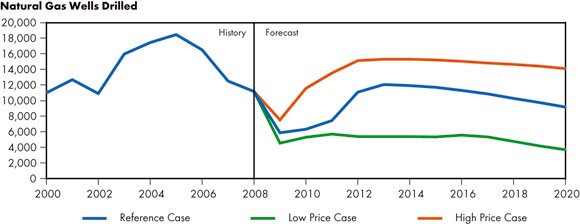
- In the 2009 Reference Case Scenario, prices in the US$7.00 to $7.50/MMBtu range would be sufficient to maintain a very gradual drilling decline in Canada from roughly 12 000 gas wells in 2013 to 9 200 by 2020. Rising shale and tight gas output in Canada would partially offset declines in conventional gas and be supplemented by frontier gas from northern Canada and off the east coast later in the projection.
- In the Low Price Case, higher cost unconventional and frontier projects in Canada would not be competitive, resulting in falling drilling rates yielding lower production and net exports. In the Low Price Case drilling remains around 5 000 wells for most of the projection and then slips lower toward the end of the period.
- In the High Price Case, drilling activity would rise and lead to greater Canadian natural gas supply. In the High Price Case, gas drilling reaches over 15 000 wells by 2012 and then declines very slowly. These levels of annual drilling are below those in the 2007 Reference Case that averaged about 18 000 natural gas wells annually. The key difference in the current cases is a greater reliance on a smaller number of more prolific wells in tight gas and shale gas areas. Projections of natural gas wells drilled are in Figure 6.1.
Production
- In the 2009 Reference Case Scenario, natural gas production is projected to decline in 2009 and 2010 due to reduced drilling. By the end of the outlook period, Reference Case Scenario production reaches 450 million m³/d (15.8 Bcf/d) (Figure 6.2). This is slightly higher than the 2007 Reference Case, which projected natural gas production to be 381 million m³/d (13.4 Bcf/d) in 2020 (Figure 6.3).
Figure 6.2 - Canadian Natural Gas Production, Reference Case Scenario
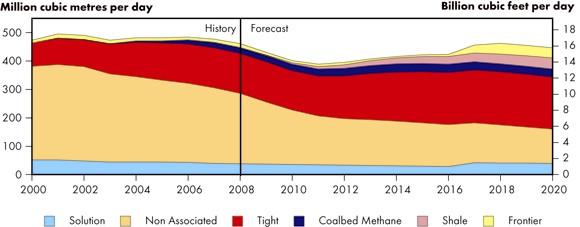
Figure 6.3 - Comparison of 2009 Reference Case Scenario and 2007 Reference Case Natural Gas Supply Outlook
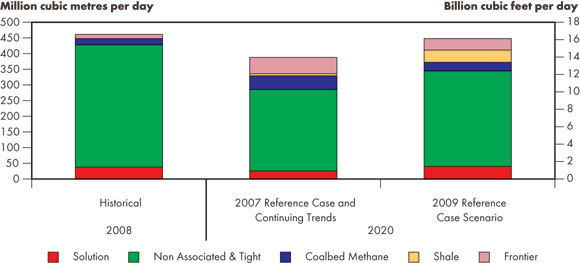
- The biggest change to North American natural gas markets since the 2007 report is the potential for significant increases in tight gas and shale gas production. The production of tight gas and shale gas in the 2007 Reference Case was considerably lower at only 42 million m³/d (1.5 Bcf/d) by 2020. The change is largely related to technology improvements in horizontal drilling and hydraulic fracturing. This development is progressing rapidly in the U.S. and is beginning to get underway in Canada. Relative to major U.S. shale regions, the development of Horn River shale gas in northeast B.C. may be disadvantaged by its remote muskeg location. This could result in higher delivery costs for equipment and materials, higher costs for pipeline transportation, and access challenges to operate year round and not be confined to winter months when the ground is sufficiently frozen to allow the movement of heavy equipment. These disadvantages are potentially offset by the considerable thickness of the shale in northeast B.C. and their potential to hold higher quantities of gas-in-place than many of the U.S. shale areas.[16]
[16] In terms of estimated full cycle supply costs, Tristone Capital Inc. analysis puts Montney shale gas among the lowest of the major North American shale gas plays at US$4.50/MMBtu and the Horn River among the highest at US$7.50/MMBtu. (Tristone Capital Inc., Can You Smell What the Rocks are Cookin' - A 260 Tcf Shale Gas Revolution, October 6, 2008.).
- Montney tight gas and Horn River shale gas in northeast B.C., is expected to play an increasingly important role in the Reference Case Scenario, partially offsetting conventional declines after 2011[17]. In 2020, tight gas and shale gas account for 220 million m³/d (7.8 Bcf/d) of Canadian supply as compared to about 140 million m³/d (5 Bcf/d) in 2008. This includes an estimated 1.13 million m³/d (0.04 Bcf/d) of shale gas production in Quebec. The conventional gas production (including solution gas but excluding tight gas) in Western Canada declines by more than half between 2007 and 2020 from 320 million m³/d (11.3 Bcf/d) to 150 million m³/d (5.3 Bcf/d). Conventional gas production accounted for almost two-thirds of total production in 2007 and its contribution slips to just one-third of total Canadian production by 2020.
[17] These assumptions are in no way suggestive of the outcome of regulatory proceedings currently underway or expected in the future.
- CBM production in Western Canada is projected to rise by almost 50 per cent between 2007 and 2016 in the Reference Case Scenario to reach almost 28 million m³/d (1.0 Bcf/d). This would include significant development of Mannville CBM to supplement the Horseshoe Canyon production that currently dominates CBM output.
- The Reference Case Scenario sees Atlantic Canada production decline at the Sable Offshore Energy Project, with production offset in late 2010 by initial flows from the nearby Deep Panuke project. In the longer term, natural gas that is produced in conjunction with offshore Newfoundland oil projects (gas that is currently re-injected to maintain reservoir pressure), will become available. This can be delivered to markets by tankers configured to carry compressed natural gas (CNG), LNG or possibly pipelines. Natural gas operation is projected to begin in 2017, although this could be delayed by continued discovery of satellite oil pools.
- Considerations for northern projects include competition from shale gas, extreme market price volatility, labour availability, cost escalation, acquiring adequate financing, and obtaining land access. Based on these considerations, the 2009 Reference Case Scenario assumes that production of Mackenzie Delta natural gas would commence in 2017. This projection represents a delay of roughly two years from the 2007 Reference Case. This project is subject to the outcome of a regulatory process currently underway and any subsequent commercial decision to proceed. These assumptions are in no way suggestive of the outcome of the regulatory process currently underway. Alaskan gas is not included in the projections to 2020.
- In the Low Price Case, Canadian natural gas production falls to 280 million m³/d (9.9 Bcf/d) and in the High Price Case it increases to 595 million m³/d (21.0 Bcf/d) (Figure 6.4).
Figure 6.4 - Canadian Natural Gas Production, Reference Case Scenario and Price Cases

- In the High Price Case, both tight and shale gas provide incremental growth to Canadian natural gas supply accounting for 280 million m³/d (10 Bcf/d). In the Low Price Case, tight gas and shale continue to make a key contribution to supply accounting for 145 million m³/d (5.1 Bcf/d) by 2020, but it is not enough to stem the decline in conventional gas.
- Conventional gas production declines least in the High Price Case to 180 million m³/d (6.4 Bcf/d) in 2020. In the Low Price Case, conventional gas production is least competitive compared to other sources of supply and production rate drops to just 48 million m³/d (1.7 Bcf/d) by 2020. This represents 17 per cent of Canadian natural gas production by the end of the projection period.
- Conventional natural gas (excluding tight gas) production in Western Canada declines in each of the cases and warrants discussion. Of the total amount of conventional natural gas (excluding tight gas) in Western Canada, less than half remains to be discovered. While some significant finds of this gas will continue to be made, the vast majority will correspond to the established trend toward smaller discoveries, lower well production rates, and higher costs. As costs rise relative to tight, unconventional, and frontier gas, conventional gas (excluding tight gas) activity will gradually be reduced and further the decline in this component of production.
- As the average size of new discoveries of conventional gas (excluding tight gas) declines over the projection period, the initial productivity of new conventional gas wells also falls. As technological advances and experience with tight gas and shale gas progresses in Canada, the more prolific output from these wells will become increasingly cost-effective relative to conventional targets. As investment migrates to tight gas and shale gas prospects, their contribution to overall production rises and eventually almost offsets declines in conventional gas production.
- The High Price Case sees CBM development rise by over 75 per cent to reach 35 million m³/d (1.2 Bcf/d) by 2020. Production from Mannville CBM is the key contributor to CBM growth. In the Low Price Case, CBM production is projected to gradually decline as activity is drawn away to tight gas and shale gas prospects. By the end of the Low Price Case, CBM output is just over half of current rates[18].
[18] CBM production in this report is considerably lower than the 62 million m³/d (2.2 Bcf/d) of CBM production anticipated in the 2007 Reference Case. The absence of a significant increase in Mannville CBM activity and the diversion of industry capital to tight gas and shale gas prospects are key factors in the revision to the outlook.
- CNG operation is projected to begin in 2017 in the Low Price Case, and in 2015 in the High Price Case.
- Mackenzie gas comes in one year early in 2016 in the High Price Case. In the Low Case, there is no Mackenzie gas on production by the end of 2020.
Liquefied Natural Gas
- Global LNG import capacity is roughly twice the annual LNG production. This excess import capacity is available to accommodate peak delivery periods and future supply growth. LNG import capacity into North America has increased to over 310 million m³/d (11 Bcf/d), including the 28 million m³/d (1.0 Bcf/d) Canaport facility in Saint John, New Brunswick. However, actual imports have rarely exceeded 85 million m³/d (3 Bcf/d) and have generally been around 28 million m³/d (1 Bcf/d) in recent years. Utilization of individual terminals will vary depending on market conditions and contractual arrangements. LNG imports into Canada are assumed to average 14 million m³/d (0.5 Bcf/d) in the Reference Case Scenario.
- Higher levels of LNG imports into North America are one of the factors contributing to lower prices in the Low Price Case. LNG imports into Canada are assumed at 28 million m³/d (1.0 Bcf/d) in the Low Price Case.
- In the High Price Case, increased global competition could limit LNG availability in regions with indigenous sources of natural gas, such as North America. LNG imports into Canada are assumed to average 3 million m³/d (0.1 Bcf/d) in the High Price Case. Note that this assumption is used to support the high price rationale of this case and does not take into account specific contractual arrangements related to individual LNG terminals.
Supply and Demand Balance
- As a result of the severe slowdown in conventional natural gas drilling activity and only gradual increase in unconventional gas drilling, Canadian natural gas production is projected to decline significantly over the 2008 to 2010 period. At the same time, Canadian natural gas demand is likely to recover and begin to grow as use for oil sands production and power generation continues to increase. This combination of declining production and rising Canadian gas requirements results in a lower net surplus available for export. Net exports are the difference between total exports and total imports.
- Over the period from 2008 to 2011, Canadian gas production in the Reference Case Scenario declines by 70 million m³/d (2.5 Bcf/d) while growing use for oil sands and power raises Canadian demand by 17 million m³/d (0.6 Bcf/d). This 88 million m³/d (3.1 Bcf/d) swing drops net exports 40 per cent by 2011. After 2011, gas supply increases at a similar rate to Canadian domestic demand resulting in stable net exports at around 140 million m³/d (5 Bcf/d) until the latter stages of the projection when the contribution from frontier gas helps push net exports to 170 million m³/d (6 Bcf/d) (Figure 6.5).
Figure 6.5 - Canadian Net Natural Gas Exports, Reference Case Scenario and Price Cases
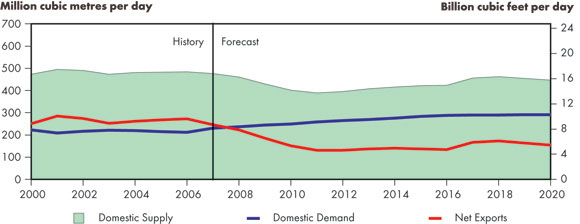
- In the Low Price Case, Canadian natural gas production declines throughout the projection, while natural gas demand rises. Under these conditions, net exports decline steadily and Canada becomes a net importer of natural gas during 2019. Costs to Canadian consumers remain low, as U.S. production and LNG imports into North America gradually eliminate the need for Canadian net natural gas exports to the U.S.
- In the High Price Case, Canadian natural gas production initially drops due to reduced drilling, but then rises steadily to be almost 24 per cent above 2008 levels by 2020. Over the same period, higher energy prices result in only modest natural gas demand growth of 11 per cent. The growing surplus is available for export and would raise net exports to a new record level by 2020.
Key Uncertainties to the Outlook
- Natural gas price movements have become more pronounced since 2007 with prices first dropping, then doubling and finally falling by more than half. With significant price movements likely to persist or even become more extreme, capital investments in upstream natural gas projects, pipelines and processing infrastructure will be exposed to greater variability in revenue streams.
- The potential increase in North American shale gas production from about 200 million m³/d (7 Bcf/d) currently to 710 million m³/d (25 Bcf/d) by 2020 could potentially be slowed by challenges associated with this new technology, such as difficulty with fracs, or shortages of key project components. Such components could include the large volumes of water used in hydraulic fracturing, the proppant material used to hold the fractures in the rock open, drilling and pressure pumping equipment, and sufficient land access for drilling and pipeline operations. These projects are also subject to regulatory approvals.
- The extent and pace of a potential recovery or possible growth of natural gas demand is difficult to ascertain. Key demand sectors are the use of natural gas for producing oil sands in Western Canada, gas consumption in Ontario industrial markets, fuel for CCS operations and gas-fired power generation. Some have speculated that with massive shale gas development, natural gas could be used much more extensively in North America for environmental benefits and to improve energy security. A massive shift of this type is not expected within the period to 2020.
- Shale and tight gas in Canada and the U.S. could represent one-third or more of North American production by 2020. Over the same period, conventional gas output is likely to decline, particularly if incremental shale and LNG volumes cause prices to remain low. While the changes may offset and keep overall North American production volumes from increasing noticeably, sources of supply will shift and may require changes to pipeline infrastructure. Conventional natural gas accounted for two-thirds of total Canadian natural gas supply in 2008, but by 2020 is only one-third with growth in tight gas and shale gas making up the difference
- Oil sands development contributed to inflation in Western Canada that helped to make gas development in the WCSB less competitive relative to other jurisdictions. Should both demand and prices increase across oil and gas commodities simultaneously, similar cost inflation could potentially reassert and impede increases in upstream development.
- In the nearer term, there is some risk that the contraction in global demand could result in excess LNG being delivered into North America, further depressing prices. Over the longer-term, sufficient North American shale gas supply could possibly be developed to warrant exports of North American LNG to global markets. Such a step could effectively link North America to global gas pricing.
Chapter 7. Natural Gas Liquids Supply Outlook
NGL Supply and Disposition
- NGLs include propane, butane, pentane plus[19] and ethane. These liquids are primarily derived from natural gas production. However, a portion of propane and butane supply comes from oil refining. It is assumed that the extraction of natural gas liquids from natural gas is economic over the long-term given the price assumptions.
[19] In this report, pentanes plus or condensate supply is reported as part of crude oil production (see Appendix 3).
- The outlook for natural gas supply in Canada is promising with the development of new natural gas production from shale and tight gas plays, as well as from CBM. However, gas from these sources is essentially devoid of liquids. The increasing relevance of these unconventional sources of gas supply as well as the steep decline in gas production projected in 2009 and 2010 in the Reference Case Scenario means that NGL production shows a net reduction in supply compared with the 2007 forecast.
- Propane demand is projected to grow at an annual average rate of 0.7 per cent during the Reference Case Scenario forecast period, with most of the demand growth concentrated in the end-use energy sectors (i.e. residential, commercial and industrial). The propane supply forecast declines in line with the reductions in conventional gas supply for each case. Excess volumes of propane are still available for export throughout the period, in each of the three price cases.
- Butane demand for the production of gasoline components and gasoline blending grows at an average 0.3 per cent per year over the 2009 Reference Case Scenario outlook. The butane supply and demand balance is projected to be tight early in the forecast period, as a consequence of the steep decline in butane production associated with reduced natural gas drilling and conventional gas production. Canada will cease to be a net butane exporter post-2012. This contrasts with the previous report, in which butane balances became tight in 2015. This shortfall could be met by butane imports or by expansion of facilities to access enhanced deep-cut and oil sands off-gas supply sources.
- Pentanes plus (or condensate) production declines through the forecast period in the 2009 Reference Case Scenario, in line with the downtrend in conventional natural gas production. Condensate demand is mainly driven by blending requirements for the growing bitumen and heavy oil production in Western Canada. Furthermore, some volumes are consumed as refinery and petrochemical feedstock in Eastern Canada. Total condensate demand in Canada outstrips available supply in all three price cases. Increasing volumes of imported condensate will be required to cover the expected demand shortfall, which is estimated at approximately 55 thousand m³/d (350 Mb/d) by 2020 in the Reference Case Scenario.
Ethane Supply and Demand Balances
- Ethane supply is projected to be increasingly tight in the period considered in the Reference Case Scenario, as demand outstrips available supply.
- In the Reference Case Scenario, ethane production declines along with WCSB conventional natural gas production (Figure 7.1). Unconventional gas supplies that arrive after 2011 only marginally slow the downward trend in ethane production. Mackenzie Delta gas, assumed in the Reference Case to come on stream in 2017, serves to mitigate the decline in ethane and other NGL production for about two years.
Figure 7.1 - Ethane Supply and Demand Balance, Reference Case Scenario
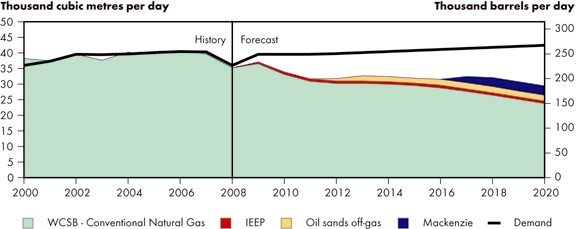
Demand includes petrochemical facilities use as well as solvent flooding.
- The gap between supply and demand could be met by projects offering additional ethane supply, such as enhanced deep-cut facilities and oil sands off-gas facilities. These, however, have been negatively impacted by higher construction and labour costs in recent years, difficulties accessing project financing due to the 2008 financial crisis, and the high volatility of the oil-natural gas price spreads. Many of these projects have either been cancelled or delayed in the outlook. Projects that count on support under Alberta's Incremental Ethane Extraction Policy (IEEP) have also been negatively impacted[20]. The result is a net reduction of the projected supply from these sources compared with the 2007 Reference Case Scenario and Continuing Trends projections.
[20] IEEP is a policy that provides incentives for additional production of ethane volumes from natural gas and gases produced as a by-product of bitumen upgrading as well as use of ethane by petrochemical companies in Alberta.
- No ethane production is expected from the East Coast or British Columbia offshore, under any of the three price cases, as the potential ethane production from these volumes is inadequate to develop an ethane-based petrochemical industry. NGL supply from LNG imports is not considered commercially viable.
- Ethane in Canada is primarily used in Western Canada as a petrochemical feedstock with small amounts being used in miscible flood projects. Ethane demand fell during the second half of 2008 due to the economic downturn in the automotive industry and the consumer goods sector - both major consumers of plastics and other petrochemicals. Demand is projected to gradually increase from the second half of 2009 onwards. Over the outlook period, slow growth in demand is expected as North America is considered a mature ethylene market. In addition, Alberta's petrochemical industry will face increased competition in North American markets from new ethylene capacity in Asia and the Middle East.
- As a result of the supply and demand outlook, no new petrochemical plants or expansions are considered, although some plant debottlenecking could be done if more ethane supplies become available. Propane, butane and naphtha are currently used as feedstock in petrochemical facilities in Eastern Canada, and some propane volumes are added as supplemental feedstock for ethylene plants in Western Canada. This situation is expected to continue in the future.
- In the Low Price Case, ethane production declines rapidly in line with falling natural gas production projections. Some deep-cut and off-gas projects are also considered in the Low Price forecast, but they come on at a later date than in the 2009 Reference Case Scenario. These projects are unable to lift ethane supply enough to counterbalance the impact of lower gas production.
- In the High Price Case, ethane production manages to increase by 2018, supported by the start-up of some deferred IEEP related projects, not considered in the 2009 Reference Case Scenario. This additional supply helps to offset lower ethane production from conventional gas, however ethane supply resumes its downward trend by the end of the period.
Key Uncertainties to the Outlook
- In all three cases, conventional gas production in Western Canada declines. Since NGLs are primarily derived from conventional gas production, any changes in the economics and production levels for conventional natural gas production will directly impact the NGLs outlook.
- Alternative sources of ethane, such as improvements in ethane extraction (enhanced deep cut facilities) or oil sands off-gas have been negatively affected by a combination of factors, including cost inflation for construction, restricted access to financing and volatile oil-gas price differentials. If these conditions are quickly alleviated then additional ethane supplies could become available over the outlook period. Alternatively, if these conditions persist, new ethane supply from these sources could be further delayed or cancelled.
Chapter 8. Electricity Supply Outlook
Capacity and Generation
- Generation capacity increases by 20.7 per cent between 2008 and 2020, with new electricity supply coming from both traditional (large hydro, nuclear, natural gas, coal, and oil) and emerging sources (wind, biomass, solar, geothermal, and small hydro) (Figure 8.1).
Figure 8.1 - Canada Electricity Generating Capacity, Reference Case Scenario
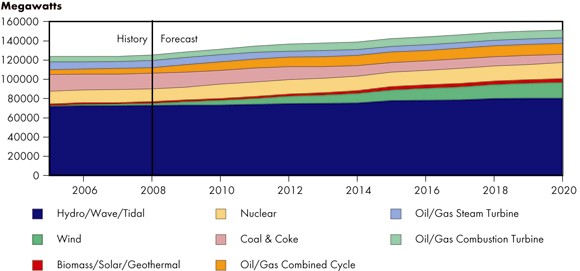
- A major trend shown in the results of this study is a push towards reducing GHG emissions. This includes energy efficiency initiatives, as well as an increased emphasis on generating technologies such as natural gas, wind, biomass, solar, nuclear and coal with CCS.
- A major source of differences between the 2007 Reference Case Scenario and the 2009 Reference Case Scenario is the decrease in electricity demand. In 2020, electric demand is 682 527 GW.h in the 2007 report but only 631 876 GW.h (7.4% lower) in the 2009 Reference Case Scenario (Figure 8.2). This leads to decreased Canadian generating capacity in 2020, mainly registered in Ontario (745 MW), BC (650 MW), and Quebec (1 381 MW).
Figure 8.2 - Generation by Fuel Comparison of 2009 Reference Case Scenario and 2007 Reference Case Scenario
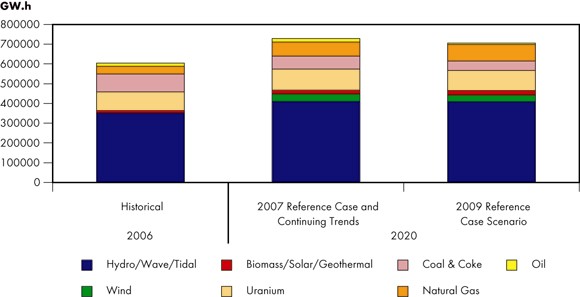
Hydro
- Hydroelectric capacity will continue to be the major source of electricity during the Reference Case Scenario timeframe, although its share decreases from 58.2 per cent of Canadian electricity generating capacity in 2008 to 53.3 per cent in 2020. Hydro-based capacity, including small hydro, is projected to reach 80 604 MW by 2020, an increase of roughly 7 751 MW from 2008.
- There will be extensive development of new hydro projects in British Columbia, Quebec, and Newfoundland and Labrador. The Reference Case Scenario assumes a 500 MW addition at the existing Revelstoke generating station, a 465 MW addition at the existing Mica generating station and the construction of the 900 MW Peace River Site C facility, all in B.C. In Eastern Canada, the 2 260 MW Lower Churchill facility in Labrador, and the Sarcelle/Eastmain-1-A / Rupert River diversion and the Romaine generating station in Quebec (2 441 MW) are constructed. In addition, the addition of the 200 MW Wuskwatim facility in Manitoba in 2012 is assumed.
- Annual hydro generation output is forecast to increase from 362 180 GW.h to 409 257 GW.h over the forecast period, although its share decreases slightly from 59.7 per cent of Canadian electricity generation in 2008 to 58.1 per cent in 2020 (Figure 8.3).
Figure 8.3 - Canada Electricity Generation by Fuel, Reference Case Scenario
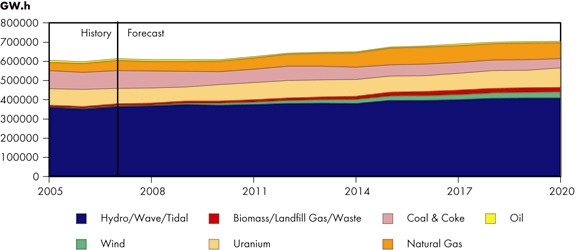
Nuclear
- Total nuclear capacity increases by 3 170 MW (23.8 per cent) during the period of the 2009 Reference Case Scenario. Nuclear additions occur in New Brunswick (680 MW in 2017) and Alberta (1 000 MW in 2020).
- It is also assumed in Ontario that two generating units at Bruce Station A (1 650 MW) return to service and that the four 540 MW Pickering Station B units are replaced with two 1 000 MW reactors in 2018 and 2019. The Point Lepreau facility in New Brunswick and the Gentilly-2 facility in Quebec are assumed to be refurbished.
- Nuclear generation output is also forecast to increase, mainly at the end of the timeline, from 78 336 GW.h to 101 905 GW.h, increasing its share of total generation from 12.9 per cent in 2008 to 14.5 per cent by 2020.
- Total Canadian nuclear capacity projected to 2020 decreased slightly by 480 MW from the previous Reference Case Scenario. Ontario nuclear capacity is projected to decrease in 2020 from 15 640 MW to 13 480 MW (-13.8 per cent) because of the retirement of older units instead of their refurbishment. However, this decrease is offset by the addition of a new 1 000 MW unit in Alberta to replace retiring coal generation in 2020 and a 680 MW unit in 2017 in New Brunswick.
Natural Gas-fired
- Natural gas will continue to be relied upon to meet increased electricity demand. Natural gas-fired generation is forecast to increase during the period of the 2009 Reference Case Scenario by an additional 5 517 MW of combined-cycle generation and 2 629 MW of combustion turbine/cogeneration facilities. A decrease of 1 243 MW of steam turbine generation is also assumed mainly in British Columbia (630 MW) and Alberta (221 MW), as older plants are replaced by more efficient combined-cycle facilities. In the near term, investment in combined-cycle generation is planned for Ontario as well as Newfoundland and Labrador. In Ontario, a combination of 3 917 MW of combined-cycle gas and 1 337 MW of combustion turbine/cogeneration facilities will be relied on to help meet demand following the phase-out of coal-fired generation.
- Natural gas-fired generation output is forecast to increase significantly from 50 809 GW.h to 82 670 GW.h in 2020, or from 8.4 per cent to 11.7 per cent of total generation.
Coal-fired
- Total coal-fired generation capacity is projected to decrease by 46.3 per cent or 7 560 MW in the 2009 Reference Case Scenario. As a result, coal's share of total generation will fall from 12.9 per cent in 2008 to only 5.7 per cent in 2020. This reduction of coal-fired generating capacity leads to a decrease in Canadian output from 88 416 GW.h in 2008 to 47 960 GW.h in 2020, a decrease of more than 45 per cent.
- The largest change occurs in Ontario, as all coal-fired generation, 7 485 MW, is retired by 2015. Additional retirements occur in Alberta, Saskatchewan and Nova Scotia as facilities reach the end of their useful lives. The Boundary Dam Number 3 unit in Saskatchewan is refurbished and fitted with CCS equipment in 2015, while in Alberta there is a new 450 MW conventional coal plant in 2011, and a 270 MW Integrated Gasification Combined Cycle pilot project in 2015 but no other new coal construction.
- There have been some changes to CCS projects between the 2007 and 2009 Reference Case Scenario. These changes reflect announced changes in the timing of pilot projects, as well as lower need for new coal generation due to reduced demand for electricity and assumptions about the potential for nuclear generation in Alberta.
Oil-fired
- Oil-fired power facilities provide generation during peak demand periods or in areas where other fossil fuelled generation is not available, such as Yukon, Nunavut and Northwest Territories. In Newfoundland and Labrador, retiring oil steam units will be replaced by a 360 MW combined-cycle oil-fired facility in 2012 and a 180 MW in 2020. The Reference Case Scenario indicates declining shares of oil-fired generation, as older steam units are replaced with natural gas-fuelled combined-cycle generation where available and economic.
- The Reference Case Scenario indicates a slight decline in the share of oil-fired generation output; 8 531 GW.h in 2008 and 7 541 GW.h in 2020, or 1.5 per cent in 2008 to 1.1 per cent in 2020.
Alternative and Emerging Technologies
- Installed unconventional emerging technology generation remains small relative to the more centralized conventional sources, but large changes are expected to occur.
- Wind power experiences exceptionally strong growth. Generation shows about a six fold increase from 4 860 GW.h in 2008 to 32 389 GW.h in 2020 (567 per cent increase over outlook period) and total wind power capacity is projected to grow from 2 369 MW in 2008 to 16 400 MW by 2020. During the Reference Case Scenario period, the largest volume of wind power additions occur in Quebec (5 885 MW), Ontario (3 280 MW), Manitoba (1 200 MW) and Alberta (1 522 MW). By the end of the outlook period, wind generating capacity is about 510 MW larger than in the 2007 Reference Case Scenario outlook, reflecting changes in announced provincial targets. The increase in provincial targets reflects both increased public interest in clean sources of electricity and greater confidence on the part of system operators with their ability to integrate wind power into their electric systems.
- Other generation technologies, such as biomass, landfill gas, waste heat, solar and tidal grow by 139 per cent to 3 750 MW by 2020. The 2009 Reference Case Scenario also includes photovoltaic (solar PV) per the Ontario Power Authority Integrated Power System Plan, plus a geothermal pilot project in B.C. Biomass, solar and geothermal sees its Canadian generation share increase about 134 per cent to 23 163 GW.h over the timeline. The majority of this output is from biomass. In Ontario, the analysis assumes conversion of the Atikokan coal plant to biomass for 2014, and the conversion of two Nanticoke coal units in 2015. Atikokan keeps its full capacity, while the two Nanticoke units are derated to 250 MW each. The location of these units favours keeping them in service, as this reduces the need for new transmission while still meeting the Ontario Government total coal phase-out target by 2014.
- In addition to the 2009 Reference Case Scenario, the NEB undertook sensitivities examining higher and lower oil prices. The same environmental policies and technological drivers in the base case and price cases are assumed; therefore installed capacity is the same in all three cases. Differences are seen in total generation and interchange.
- The Low and High Price Cases do show differences in total generation and interchange. These reflect changes in demand for electricity, which is higher in oil producing regions in the High Price Case, and lower in the Low Price Case. The opposite is true in industrial regions of Canada. This leads to more hydro generation in the Low Price Case, while the High Price Case sees more generation from coal.
Exports, Imports and Interprovincial Transfers
- Electricity exports increase 59 per cent from 55 TW.h in 2008 to 86 TW.h in 2020. Imports decline 46 per cent from 25 TW.h to 13 TW.h in 2020.
- Canadian net exports increase from 29 468 GW.h in 2008 to 73 418 GW.h in 2020. There is also an increase in inter-provincial transfers from 55 350 GW.h in 2008 to 81 245 GW.h in 2020 as power from the Lower Churchill hydro development in Labrador must be wheeled through Quebec and/or the Atlantic provinces before it can be exported.
- Export revenues will continue to be dominated by hydroelectric generation provinces. Electricity exports are expected to continue to be a significant source of revenue, and imports are expected to provide reliability for those provinces interconnected with adjacent U.S. regions. In addition to exporting power, hydro-rich provinces can also benefit from their ability to energy bank - purchase cheap power off-peak, and save water that can be used to generate electricity when prices are higher.
Figure 8.4 - Interprovincial Electricity Transfers and Net Exports, Reference Case Scenario

Key Uncertainties to the Outlook
- A prolonged economic slowdown could impact volatility and the level of Canadian fuel and electricity prices, demand and generating requirements, infrastructure investment, export and import volumes and revenues, as well as make wind energy and other renewable technologies less feasible and attractive for the industry.
- The forecast assumes slowing electric demand growth. If this deceleration does not materialize then more generation will be required.
- The implementation of government policies that are currently in the development stage has the potential to influence the electricity supply outlook presented here.
Chapter 9. Coal Supply Outlook
- The great majority of coal resources and production is located in Western Canada (B.C., Alberta and Saskatchewan) and small amounts are produced in New Brunswick and Nova Scotia. Exports are composed of mainly metallurgical coal and some thermal coal (used in power generation) and are primarily shipped from west coast ports mostly to Japan and Southeast Asia. Smaller amounts are sent to the U.S., Central America and Europe. Both types of coal are imported into Ontario and points east. Due to transportation costs and coal quality requirements, shipments from western to eastern Canada are usually limited and therefore constitute a small portion of consumption.
- About 88 per cent of domestic coal consumption is related to thermal demand in power generation, and the remainder is used in the industrial sector (Figure 9.1). The outlook for coal demand in Canada is thus critically tied to its use in power generation. Production, on the other hand, will tend to be driven by developments in the export market and thermal demand in Western Canada. Coal imports will reflect trends in eastern Canadian thermal consumption and demand for coke in steel production.
- On the basis of energy demand projected for the 2009 Reference Case Scenario, coal demand declines, reflecting the reduction in coal-fired generation. The key feature is the phase-out of coal generation in Ontario, which occurs by 2015. Some decline is evident in other provinces, reflecting plant retirements and improvements in efficiency from retrofits and new units. Clean coal technologies are introduced to improve environmental acceptability of coal-fired generation.[21] Declining demand in the steel industry and other industrial uses is also expected.
[21] For information on clean coal technologies refer to these NEB publications: Coal-Fired Power Generation: A Perspective, Canada's Energy Future: Reference Case and Scenarios to 2030, and Emerging Technologies in Electricity Generation.
- The projected increase in net coal exports is the outcome of divergent trends in exports and imports. Exports are expected to grow with the increase in world demand for steel, although growth of about one per cent per year is less than the anticipated growth in world coal trade. Imports decline substantially with the reduction in thermal requirements.
- By 2020, overall coal production declines to 63 Mt relative to production in recent years of 66 to 69 Mt (Figure 9.1).
Figure 9.1 - Canadian Coal Production and Disposition, 2005 and 2020, Reference Case Scenario
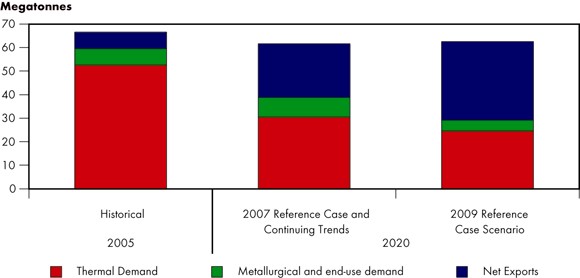
The sum of Canadian thermal, metallurgical, and end-use coal demand as well as exports is equal to Canadian production.
- Relative to the 2007 Reference Case, the biggest change in the coal outlook to 2020 comes about from the reduced use in power generation. On balance, the apparent firming up of plans to phase out or reduce output from coal-fired units seems more likely, given the apparent success and improved prospects for developing alternatives (renewables, natural gas and nuclear) since the 2007 projections were undertaken. These trends are reinforced by a lower outlook for electricity demand in this analysis.
- The higher and lower oil price cases do not greatly impact the coal analysis because, apart from the possible addition of a carbon price in some situations, coal is expected to maintain its competitive position. The impact on coal is more indirect, through the effect of price changes on the economy and energy demand, which in turn impacts power generation.
Key Uncertainties to the Outlook
- While the assumptions around retirement of coal-fired units seem achievable, there is still the matter of implementing the implied changes in the generation mix. On the other hand, should it be necessary, the retirement of coal units can be deferred and would result in higher coal consumption. The eventual outcome will be guided by private investment decisions and a combination of federal and provincial policies.
Conclusions
- The 2009 Reference Case Scenario provides an update to and an extension of the Reference Case analysis in the Board's 2007 report on Canada's Energy Future: Reference Case and Scenarios to 2030. The updated analysis considers a likely impact of recent economic, energy and policy trends on energy demand and supply in Canada. The changes to the 2007 Reference Case include a slowing Canadian and global economy, higher energy prices, greater emphasis on energy and environment programs to contain energy demand, and technological advancements, especially in the production from unconventional sources. Key assumptions include average GDP growth of 2.1 per cent per year; average WTI price of crude at $US80/bbl; average Henry Hub price of natural gas at US$6.80/MMBtu; and incorporation of energy and environmental programs and policies that have been legislated and are in place.
- Given the high level of volatility in energy markets, the 2009 Reference Case Scenario also incorporates a Low and High Price Case. The price of oil varies between a high of US$120/bbl and a low of US$60/bbl. The price of natural gas varies between a high of US$11/MMBtu and a low of US$5.50/MMBtu. The impact of Low and High Price Cases is felt more strongly at the regional level due to sectoral concentration of energy production in some regions. The energy-producing sectors see an increase in development and production under higher prices, whereas the energy consuming sectors experience higher costs. Due to Canada's strong position as both an energy producer and consumer, these contrary effects are muted at the national level.
- The analysis suggests that the broad conclusions of the 2007 Report remain intact despite the above changes. Canadians can expect energy markets to function well. Energy prices will provide appropriate market signals for the development of adequate energy resources to meet Canadian and export demand. A large proportion of Canadian demand for energy will be met by fossil fuels.
- Within the broader trends, the analysis illustrates some notable shifts. Energy demand grows at a slower pace, and combined with a move towards greener fuels, should result in slowing GHG emissions growth. There is also a significant shift towards unconventional production of oil and gas. Penetration of unconventional and "greener" technologies also rise notably in the electricity generation sector.
- The analysis recognizes the growing interconnections between energy, environment and economy. This implies that environment and economy will provide an increasingly influential context to energy decisions. These considerations may lead to some fundamental shifts in how energy is consumed and produced in Canada and globally. In Canada, interest in environmental goals continues to evolve. Since the 2007 Report, numerous federal and provincial policies aimed at sustainability and containing energy demand and GHG emissions have been advanced. The extent and schedule of climate change measures varies significantly by province, but the notable development is that all provinces now have some mix of energy efficiency and climate change initiatives. As these initiatives are crystallized, they will influence the results of future energy demand and supply analyses.
Glossary
| Alternative or Emerging Technologies | Emerging Technologies used as an alternative to existing resource-intensive methods to produce energy. Alternative technologies make limited use of resources, and include fuel cells and clean coal technologies, for example. |
| Barrel | One barrel is approximately equal to 0.159 cubic metres or 158.99 litres or approximately 35 imperial gallons. |
| Biomass | Organic material, such as wood, crop waste, municipal solid waste, hog fuel and pulping liquor, processed for energy production. |
| Bitumen or crude bitumen | A highly viscous mixture, mainly hydrocarbons heavier than pentanes. In its natural state, it is not usually recoverable at a commercial rate through a well because it is too thick to flow. |
| Capacity (Electricity) | The maximum amount of power that a device can generate, use or transfer, usually expressed in megawatts. |
| Carbon capture and storage (CCS) | A method of capturing and storing CO2, such that it is not released into the atmosphere, hence reducing GHG emissions. Carbon dioxide is compressed into a transportable form, moved by pipeline or tanker, and stored in some medium, such as geological formations. |
| Cellulosic ethanol | Also known as cellanol, cellulosic ethanol is produced from lignocellulose, and composed of cellulose, hemicellulose and lignin. It is found in a variety of biomass sources. |
| Clean coal technologies | Clean coal technologies refer to methods in which emissions resulting from coal-fired generation may be reduced. Development of clean coal technologies is currently focused on reducing emissions of CO2. Clean coal technologies may generally be characterized as improved efficiency in combustion, stack gas cleanup and capture and sequestration of CO2. |
| CO2 flooding | CO2 flooding is a process of improved oil recovery, wherein CO2, in a liquid form, is deposited into oil-bearing formations in an effort to increase the amount of oil that can be extracted. |
| Coalbed methane (CBM) | A form of natural gas extracted from coalbeds. Coalbed methane (CBM) is distinct from typical sandstone or other conventional gas reservoir, as the methane is stored within the coal by a process called adsorption. |
| Cogeneration | A generating facility that produces electricity and another form of useful thermal energy, such as heat or steam as a by-product of generation. |
| Combined-cycle generation | The production of electricity using combustion turbine and steam turbine generation units simultaneously. |
| Condensate | A mixture comprised mainly of pentanes and heavier hydrocarbons recovered as a liquid from field separators, scrubbers or other gathering facilities or at the inlet of a natural gas processing plant before the gas is processed. |
| Conventional crude oil | Crude oil, which at a particular point in time, can be technically and economically produced through a well using normal production practices and without altering the natural viscous state of the oil. |
| Conventional natural gas | Conventional natural gas is gas contained in higher porosity geological formations that is produced by expansion of the gas molecules into the well bore. |
| Crude Oil | A mixture, consisting mainly of pentanes and heavier hydrocarbons that exists in the liquid phase in reservoirs and remains liquid at atmospheric pressure and temperature. Crude oil may contain small amounts of sulphur and other non- hydrocarbons, but does not include liquids obtained from the processing of natural gas. |
| Cyclic steam stimulation | A repeateable, thermal in situ recovery technique involving steam injection followed by oil production from wells injected with steam. Steam injection increases oil mobility and allows heated bitumen to flow into a well. |
| Demand-side management | Actions undertaken by a utility that result in a change and/or sustained reduction in demand for electricity. This can eliminate or delay new capital investment for production or supply infrastructure and improve overall system efficiency. |
| Diluent | Any lighter hydrocarbon, usually pentanes plus, added to heavy crude oil or bitumen in order to facilitate its transport in crude oil pipelines. |
| End-use demand | Energy used by consumers in the residential, commercial, industrial and transportation sectors. |
| Energy efficiency | Technologies and measures that reduce the amount of energy and/or fuel required for the same work. |
| Energy intensity | The amount of energy used per unit of real GDP. |
| Ethane | The simplest straight-chain hydrocarbon structure with two carbon atoms. |
| Ethylene | A chemical building block made up of two carbon atoms and four hydrogen atoms used to manufacture plastics, solvents, pharmaceuticals, detergents and additives. |
| Extraction | A process unique to the oil sands industry, in which bitumen is separated from the oil sands. |
| Feedstock | Natural gas or other hydrocarbons used as an essential component of a process for the production of a product. |
| Fossil fuel | Hydrocarbon-based fuel sources such as coal, natural gas, natural gas liquids and crude oil. |
| Frontier areas | Generally, the northern and offshore areas of Canada. |
| Fuel economy | The average amount of fuel consumed by a vehicle to travel a certain distance, measured in litres per 100 kilometres. |
| Fuel-switching | The ability to substitute one fuel for another, generally based on price and availability. |
| Gas well | A well bore with one or more geological horizons capable of producing natural gas. |
| Generation (electricity) | The process of producing electric energy by transforming other forms of energy. Also, the amount of energy produced. |
| Geothermal energy | The use of geothermal heat to generate electricity. Also used within energy demand to describe ground-source heating and cooling (also known as geoexchange or ground-source heat pump). |
| Greenhouse effect | An atmospheric phenomenon through which incoming solar short-wave radiation passes through the atmosphere relatively unimpeded, but long-wave radiation emitted from the warm surface of earth is partially absorbed, adding net energy to the lower atmosphere and underlying surface, thereby increasing their temperatures. |
| Greenhouse gases (GHG) | Gases such as carbon dioxide, methane and nitrogen oxide, which actively contribute to the atmospheric greenhouse effect. Greenhouse gases also include gases generated through industrial processes such as hydroflurocarbons, perflurocarbons and sulphur hexafluoride. |
| Gross domestic product (GDP) | GDP is a measure of economic activity within a country. It is the market value of all goods and services in a year within Canada's borders. |
| Gross output | The value of net output or gross domestic product plus consumption. |
| Heating oil | Also known as No. 2 fuel oil. A distillate fuel oil commonly used for household space heating. |
| Heavy crude oil | Heavy crude oil Generally, a crude oil that has a density greater than 900 kg/m³. |
| Heavy fuel oil | No. 6 fuel oil (residual fuel oil) |
| Henry Hub (price) | Henry Hub is the pricing point for natural gas futures traded on the New York Mercantile Exchange (NYMEX). The hub is a point on the natural gas pipeline owned by Sabine Pipe Line and located in Louisiana. |
| Heritage assets | An amount of energy and capacity determined by the existing generation assets that resulted from past decisions under a previous market regime. This energy is generally sold into the marketplace at a price reflecting historical costs. |
| Hub | A geographic location where large numbers of buyers and sellers trade a commodity and where physical receipts and deliveries occur. |
| Hydroelectric generation | A form of renewable energy wherein electricity is produced from hydropower. |
| Hydraulic fracture | A technique in which fluids are injected underground to create or expand existing fractures in the rock, allowing oil or gas to flow out of the formation, or to flow at a faster rate. |
| In-situ recovery | The process of recovering crude bitumen from oil sands other than by surface mining. |
| Integrated Gasification Combined Cycle (IGCC) | Coal (or biomass fuel), water and oxygen, are fed to a gasifier, which produces syngas. This gas is cleaned and is fed to a gas turbine. The hot exhaust of the gas turbine and heat recovered from the gasification process are routed through a heat-recovery generator to produce steam, which drives a steam turbine to produce electricity. |
| Interchange (interprovincial) | Electricity transfers between provinces. |
| Light crude oil | Generally, crude oil having a density less than 900 kg/m³. Also a collective term used to refer to conventional light crude oil, upgraded heavy crude oil and pentanes plus. |
| Light fuel oil | No. 2 fuel oil (furnace fuel oil). |
| Liquefied natural gas (LNG) | Liquefied natural gas is natural gas in its liquid form. Natural gas is liquefied by cooling, and the process reduces the volume of gas by more than 600 times, allowing for efficient transport via LNG tanker. |
| Marketable natural gas | The volume of gas that can be sold to the market after allowing for removal of impurities and after accounting for any volumes used to fuel surface facilities. As used in this report for undiscovered volumes, it is determined by applying the average surface loss from existing pools in that formation to the recoverable volumes of undiscovered pools of the same formation. |
| Metallurgical coal | Coal used in the steelmaking industry. |
| Mine mouth | A method of integrated mining and power generation, wherein coal is transported directly out of the ground into a power plant. |
| Naphtha | A category of liquids from the middle distillate cut of crude oil. It includes end products such as benzene, toluene and xylene. |
| Natural gas liquids (NGL) | Those hydrocarbon components recovered from natural gas as liquids. These liquids include, but are not limited to, ethane, propane, butanes and pentanes plus. |
| Oil sands | Sand and other rock material that contains bitumen. Each particle of oil sand is coated with a layer of water and a thin film of bitumen. |
| Oil sands off-gas | A by-product gas stream obtained from the upgrading of bitumen extracted from oil sands that is rich in natural gas liquids and olefins. |
| Particulate matter (PM) | Atmospheric particles composed of both natural materials, such as pollen and dust, and manmade pollutants, such as smoke particles and metallic ash. Particulate matter can cause respiratory irritation in significant concentrations. |
| Pentanes Plus | A mixture mainly of pentanes and heavier hydrocarbons obtained from the processing of raw gas, condensate or crude oil. |
| Personal disposable income | The amount of income available to a household or person after the deduction of federal and provincial income taxes. |
| Photovoltaic (solar PV) | Solar power employing solar cells or solar photovoltaic arrays to convert sunlight into electricity. |
| Primary energy demand | The total requirement for all uses of energy, including energy used by the final consumer, intermediate uses of energy in transforming one energy form to another, and energy used by suppliers in providing energy to the market. |
| Real price | Price levels that are held constant, eliminating the effect of inflation. |
| Reliability | The degree of performance of any element of an electricity system, which results in electricity being delivered to customers within acceptable standards and in the amount desired. Reliability can be measured by frequency, duration or magnitude of adverse effects on electricity supply. |
| Reserves | Reserves are estimated remaining marketable quantities of oil and natural gas and related substances anticipated to be recoverable from known accumulations, as of a given date, based on analysis of drilling, geological, geophysical, and engineering data; the use of established technology; specified economic conditions, which are generally accepted as being reasonable, and shall be disclosed. |
| Reserve to Production Ratio | Reserve to Production ratio is defined as the remaining reserves at the end of any year divided by the production in that year. The result is the length of time that those remaining reserves would last if production were to continue at that rate. It should not be considered the number of producing years left, as reserves do not include resources estimated to exist, but yet to be discovered. |
| Residual fuel oil | The remaining refinery product after the removal of more valuable fuels such as gasoline and middle distillates. It is used primarily for power generation and fuel for various industrial processes. |
| Resources | As used in this report, resources refers to the total volume of oil or natural gas that is thought to be found in an area, or to that portion of the total resources that is not penetrated by a wellbore to date, or the volume that could be found as a result of appreciation. |
| Secondary energy demand | See End-use demand. |
| Shale gas | A continuous, low-grade accumulation of natural gas contained in rocks such as shales or silty shales. |
| Solar energy | Includes active and passive solar heat collection systems and photovoltaics. |
| Steam assisted gravity drainage | Steam Assisted Gravity Drainage is a steam stimulation technique using pairs of horizontal wells in which the bitumen drains, by gravity, into the producing wellbore, after it has been heated by the steam. In contrast to cyclic steam stimulation, steam injection and oil production are continuous and simultaneous. |
| Straddle plant | A reprocessing plant located on a gas pipeline. It extracts natural gas liquids from previously processed gas before the gas leaves or is consumed within the province. |
| Supply cost | Expresses all costs associated with resource exploitation as an average cost per unit of production over the project life. It includes capital costs associated with exploration, development, production, operating costs, taxes, royalties and producer rate of return. |
| Synthetic crude oil | Synthetic crude oil is a mixture of hydrocarbons generally similar to light sweet crude oil, derived by upgrading crude bitumen or heavy crude oil. |
| Thermal generation | Energy conversion in which fuel is consumed to generate heat energy which is converted to mechanical energy and then to electricity. |
| Time-of-use rate | Rates that are based on the time of day when the electricity is actually used. These rates allow consumers to pay less for the electricity used during "off-peak" or low-demand periods. Electricity used during "on-peak" hours is more costly. |
| Unconventional crude oil | Crude oil that is not classified as conventional crude oil including bitumen. |
| Unconventional natural gas | Natural gas which is not classified as conventional natural gas. It includes coalbed methane, tight gas, shale gas and gas hydrates. |
| Unconventional resources | Unconventional resources exist in petroleum accumulations that are pervasive throughout a large area and that are not significantly affected by hydrodynamic influences. They may also be associated with abnormal trap types, reservoir quality, chemical and physical form of the hydrocarbon in its native state, extraction methods (mines versus wells), or the amount of processing that must be applied to the raw production to yield a marketable commodity. |
| Upgraded bitumen | The process of converting bitumen or heavy crude oil into a higher quality crude oil either by the removal of carbon (coking) or the addition of hydrogen (hydroprocessing). |
| Upstream | Those activities related to the development, production, extraction and recovery of natural gas, natural gas liquids and crude oil. |
| Wave / Tidal power | Also known as tidal energy, tidal or wave power makes use of the rise and fall in sea levels, or tidal flow, to create hydropower. |
| West Texas Intermediate (WTI) | WTI is a light sweet crude oil, produced in the United States, which is the benchmark grade of crude oil for North American price quotations. |
Conversion Tables
Imperial and Metric Conversions |
||
| Unit | Equivalent | |
|---|---|---|
| m | metre | 3.28 feet |
| m³ | cubic metres | 6.3 barrels (oil); 35.3 cubic feet (gas) |
| t | metric tonne | 2200 pounds |
Energy Content Equivalents |
||
| Energy Measure | Energy Content | |
|---|---|---|
| GJ | gigajoule | 0.95 million btu |
| PJ | petajoule | 1 000 000 GJ |
| Electricity | ||
| MW | megawatt | |
| GW.h | gigawatt hour | 3600 GJ |
| TW.h | terawatt hour | 3.6 PJ or 1 000 GWh |
| Natural Gas | ||
| Mcf | thousand cubic feet | 1.05 GJ |
| Bcf | billion cubic feet | 1.05 PJ |
| Tcf | trillion cubic feet | 1.05 EJ |
| Natural Gas Liquids | ||
| m³ | ethane | 18.36 GJ |
| m³ | propane | 25.53 GJ |
| m³ | butane | 28.62 GJ |
| Crude Oil | ||
| m³ | Light | 38.51 GJ |
| m³ | Heavy | 40.90 GJ |
| m³ | Pentanes plus | 35.17 GJ |
| Coal | ||
| t | Anthracite | 27.70 GJ |
| t | Bituminous | 27.6 GJ |
| t | Subbituminous | 18.80 GJ |
| t | Lignite | 14.40 GJ |
| Petroleum Products | ||
| m³ | Aviation Gasoline | 33.52 GJ |
| m³ | Motor Gasoline | 34.66 GJ |
| m³ | Petrochemical Feedstock | 35.17 GJ |
| m³ | Naphtha Specialties | 35.17 GJ |
| m³ | Aviation Turbo Fuel | 35.93 GJ |
| m³ | Kerosene | 37.68 GJ |
| m³ | Diesel | 38.68 GJ |
| m³ | Light Fuel Oil | 38.68 GJ |
| m³ | Lubricants | 39.16 GJ |
| m³ | Heavy Fuel Oil | 41.73 GJ |
| m³ | Still Gas | 41.73 GJ |
| m³ | Asphalt | 44.46 GJ |
| m³ | Petroleum Coke | 42.38 GJ |
| m³ | Other Products | 39.82 GJ |
Guide to Appendices
Appendices are available on the Boards' Website at www.neb-one.gc.ca, and include the following detailed data.
The appendices are available in Adobe Acrobat (PDF) format only:
2009 Reference Case Scenario: Canadian Energy Demand and Supply to 2020 - An Energy Market Assessment - Appendices [PDF 2015 KB]
Appendix 1 Key Drivers |
|
| Table A1.1 | Economic Indicators: Canada |
| Tables A1.2 to A1.12 | Economic Indicators: Provinces |
Appendix 2 Energy Demand |
|
| Table A2.1 | Demand, Reference Case, Canada |
| Tables A2.2 to A2.14 | Demand, Reference Case, Provinces |
| Table A2.15 | Demand, Low Price Case, Canada |
| Tables A2.16 to A2.28 | Demand, Low Price Case, Provinces |
| Table A2.29 | Demand, High Price Case, Canada |
| Tables A2.30 to A2.42 | Demand, High Price Case, Provinces |
Appendix 3 Oil and Natural Gas Liquids |
|
| Table A3.1 | Crude Oil and Bitumen Resources |
| Table A3.2 | Refinery Feedstock Requirements and Sources, Canada |
| Tables A3.3 to A3.7 | Refinery Feedstock Requirements and Sources, Provinces |
| Table A3.8 | Supply and Disposition of Light Domestic Crude Oil and Equivalent, Canada |
| Table A3.9 | Supply and Disposition of Heavy Domestic Crude Oil and Equivalent - Canada |
| Table A3.10 | Ethane Supply, Demand and Potential Exports |
| Table A3.11 | Propane Supply, Demand and Potential Exports |
| Table A3.12 | Butane Supply, Demand and Potential Exports |
| Table A3.13 | Pentanes Plus Supply, Demand and Potential Exports |
| Table A3.14 | Oil, Reference Case, Production Outlook by Province |
| Table A3.15 | Oil, Low Price Case, Production Outlook by Province |
| Table A3.16 | Oil, High Price Case, Production Outlook by Province |
Appendix 4 Natural Gas |
|
| Table A4.1 | Natural Gas Supply |
| Table A4.2 | Natural Gas, Reference Case, Production Outlook |
| Table A4.3 | Natural Gas, Low Price Case, Production Outlook |
| Table A4.4 | Natural Gas, High Price Case, Production Outlook |
| Table A4.5 | Natural Gas, Reference Case, Outlook for Gas Wells Drilled in Western Canada |
| Table A4.6 | Natural Gas, Low Price Case, Outlook for Gas Wells Drilled in Western Canada |
| Table A4.7 | Natural Gas, High Price Case, Outlook for Gas Wells Drilled in Western Canada |
Appendix 5 Electricity |
|
| Table A5.1 | Capacity by Plant Type, Reference Case |
| Table A5.2 | Capacity by Plant Fuel, Reference Case |
| Table A5.3 | Generation by Plant Type, Reference Case |
| Table A5.4 | Generation by Fuel, Reference Case |
| Table A5.5 | Interchange, Reference Case |
| Table A5.6 | Capacity by Plant Type, Low Price Case |
| Table A5.7 | Capacity by Plant Fuel, Low Price Case |
| Table A5.8 | Generation by Plant Type, Low Price Case |
| Table A5.9 | Generation by Fuel, Low Price Case |
| Table A5.10 | Interchange, Low Price Case |
| Table A5.11 | Capacity by Plant Type, High Price Case |
| Table A5.12 | Capacity by Plant Fuel, High Price Case |
| Table A5.13 | Generation by Plant Type, High Price Case |
| Table A5.14 | Generation by Fuel, High Price Case |
| Table A5.15 | Interchange, High Price Case |
Appendix 6 Coal |
|
| Table A6.1 | Coal Supply and Demand, Reference Case |
| Table A6.2 | Coal Supply and Demand, Low Price Case |
| Table A6.3 | Coal Supply and Demand, High Price Case |
- Date modified:
